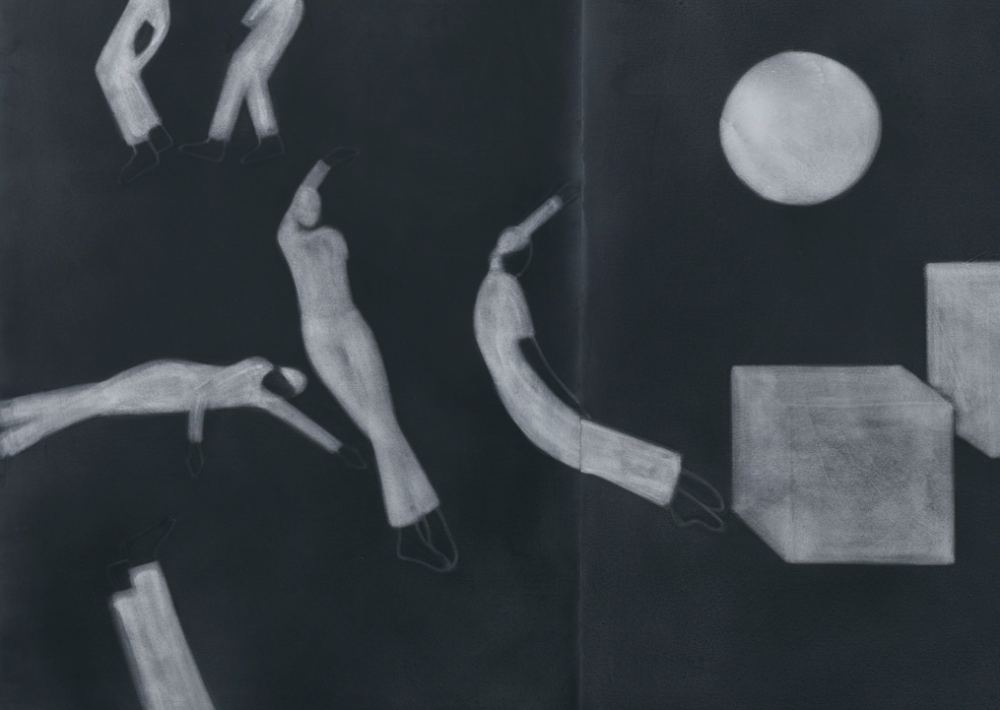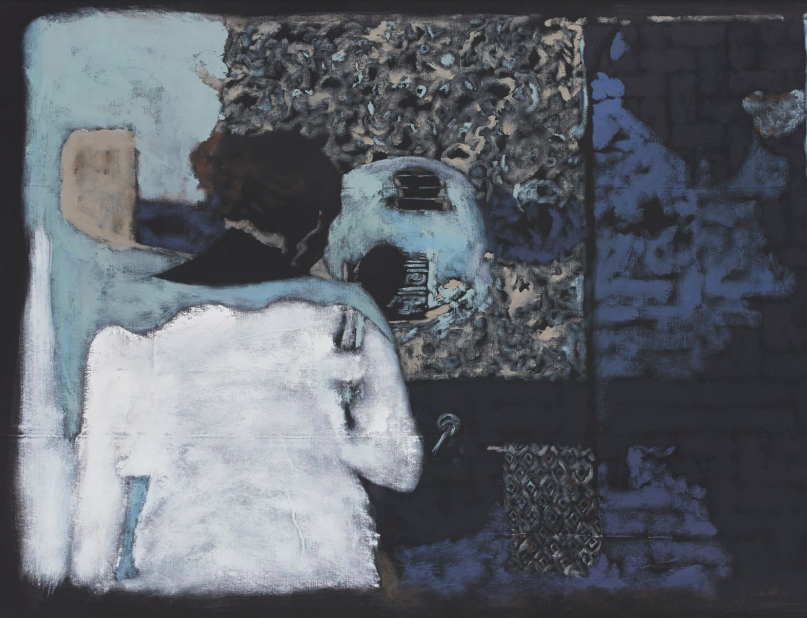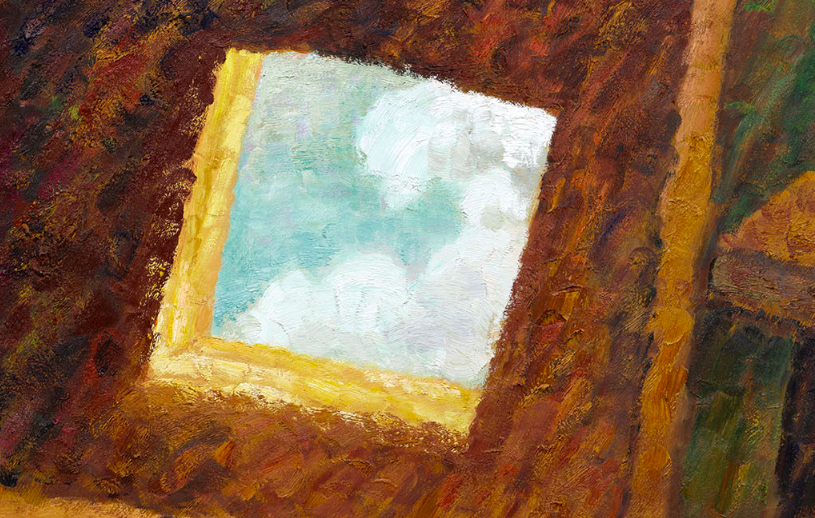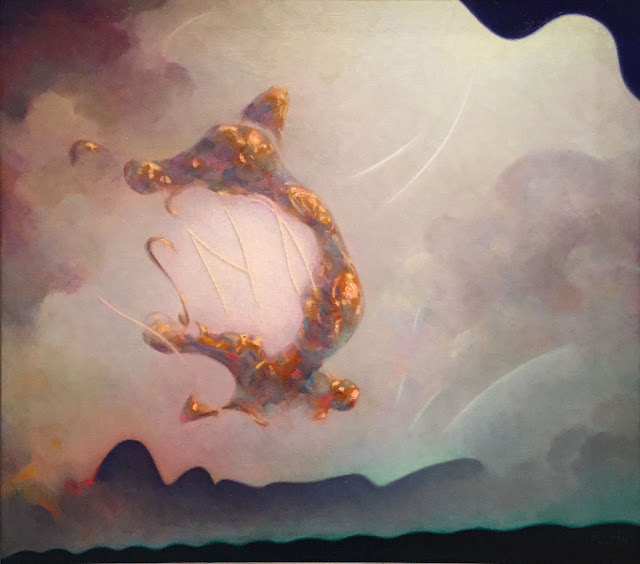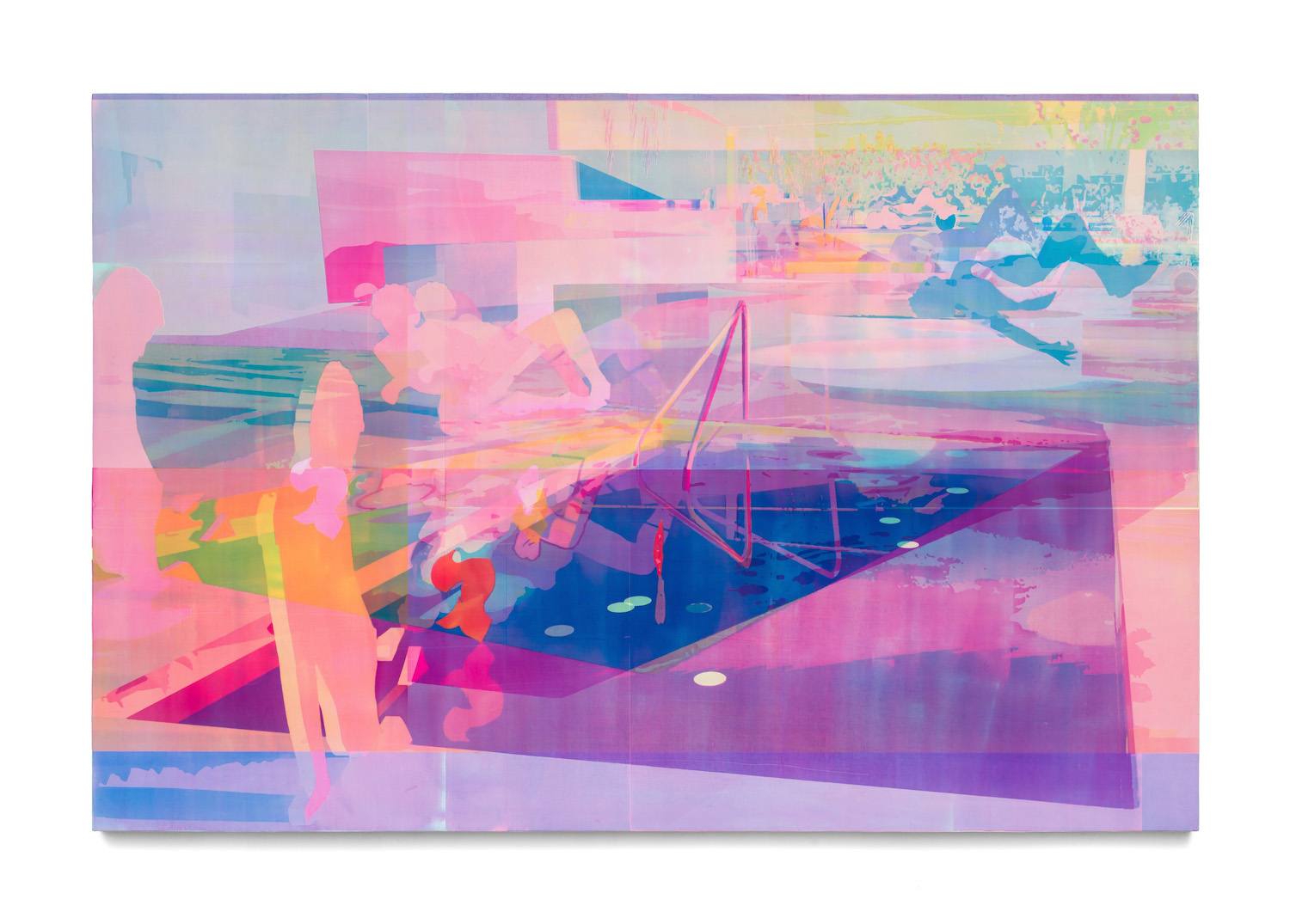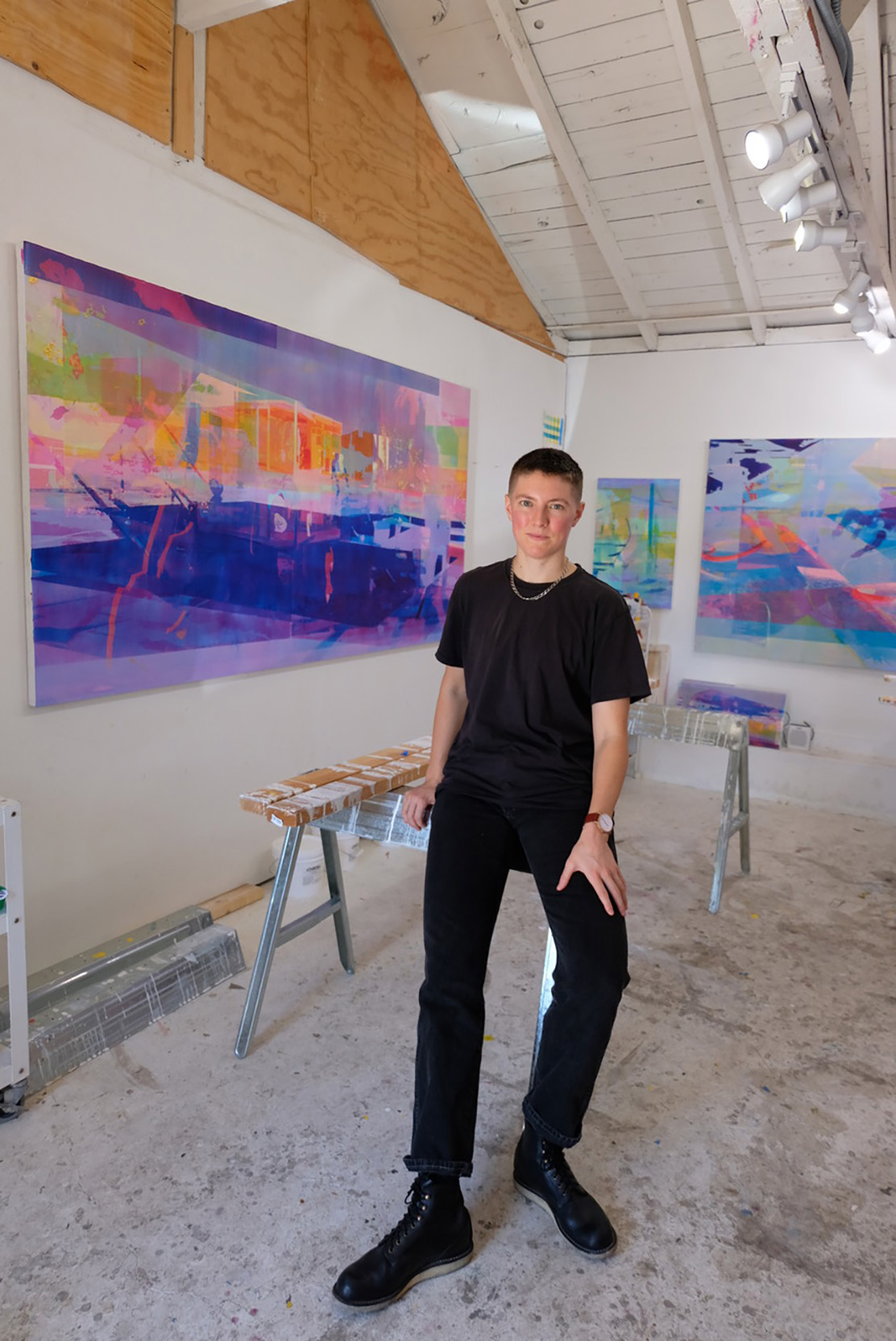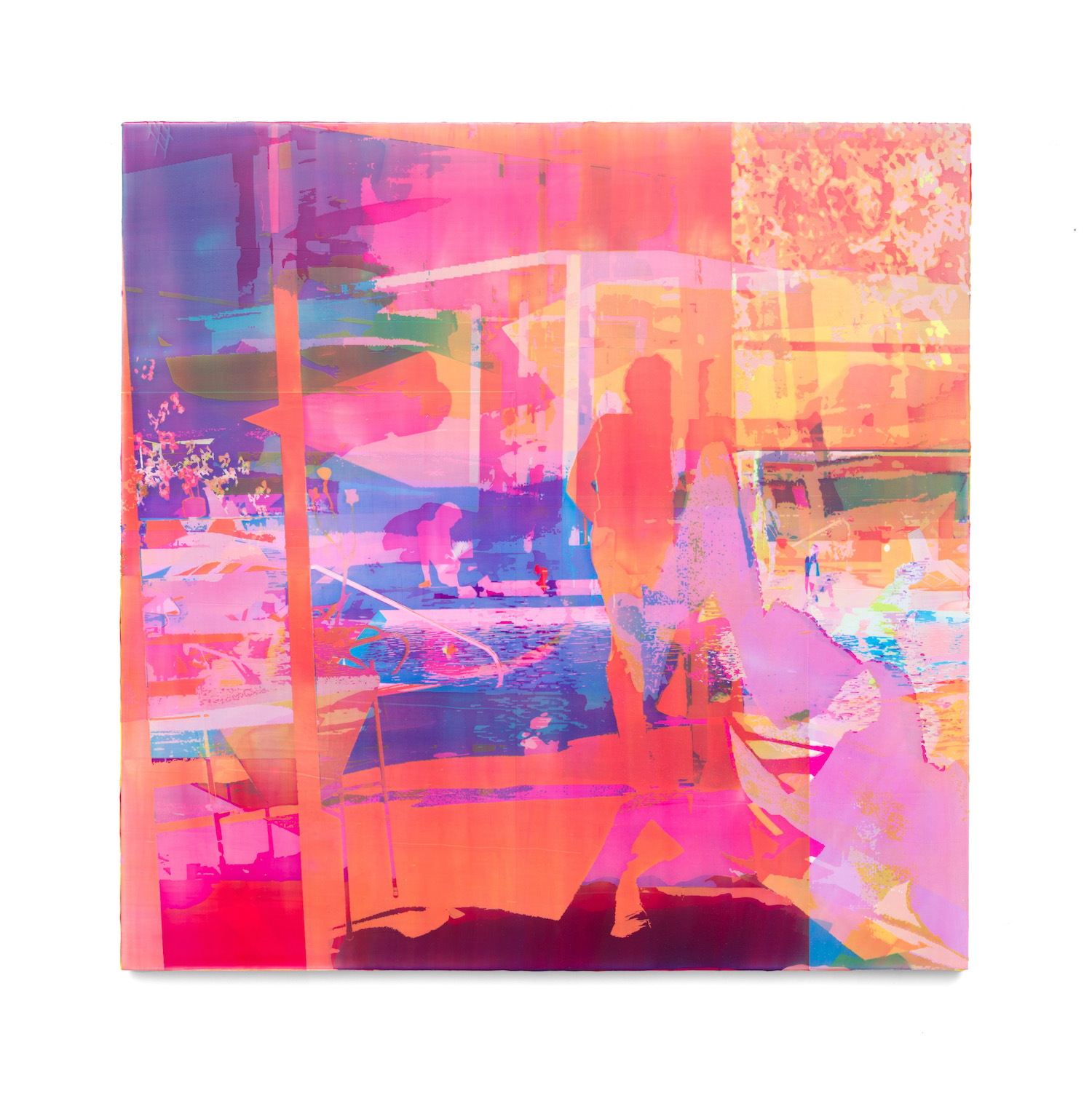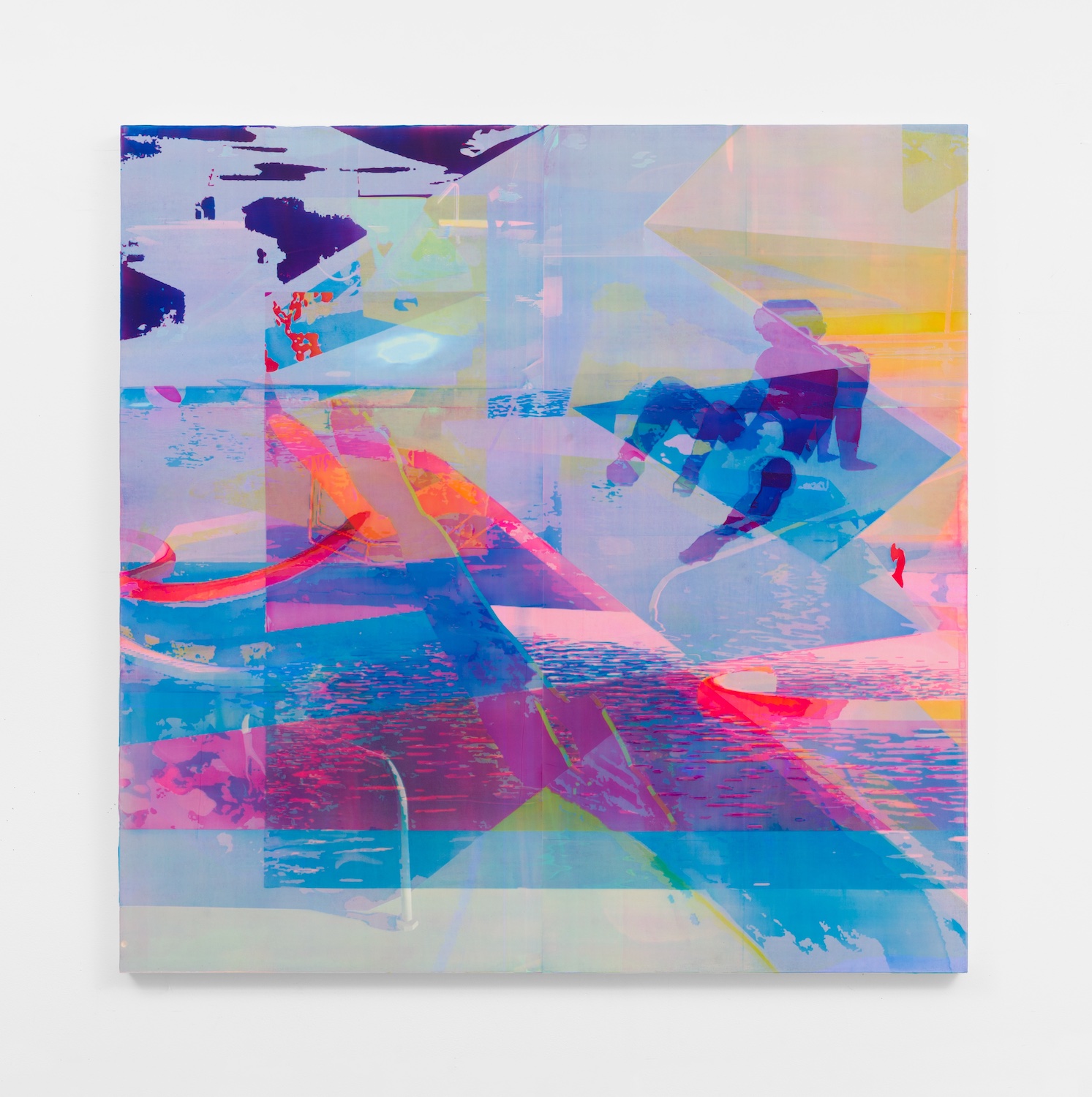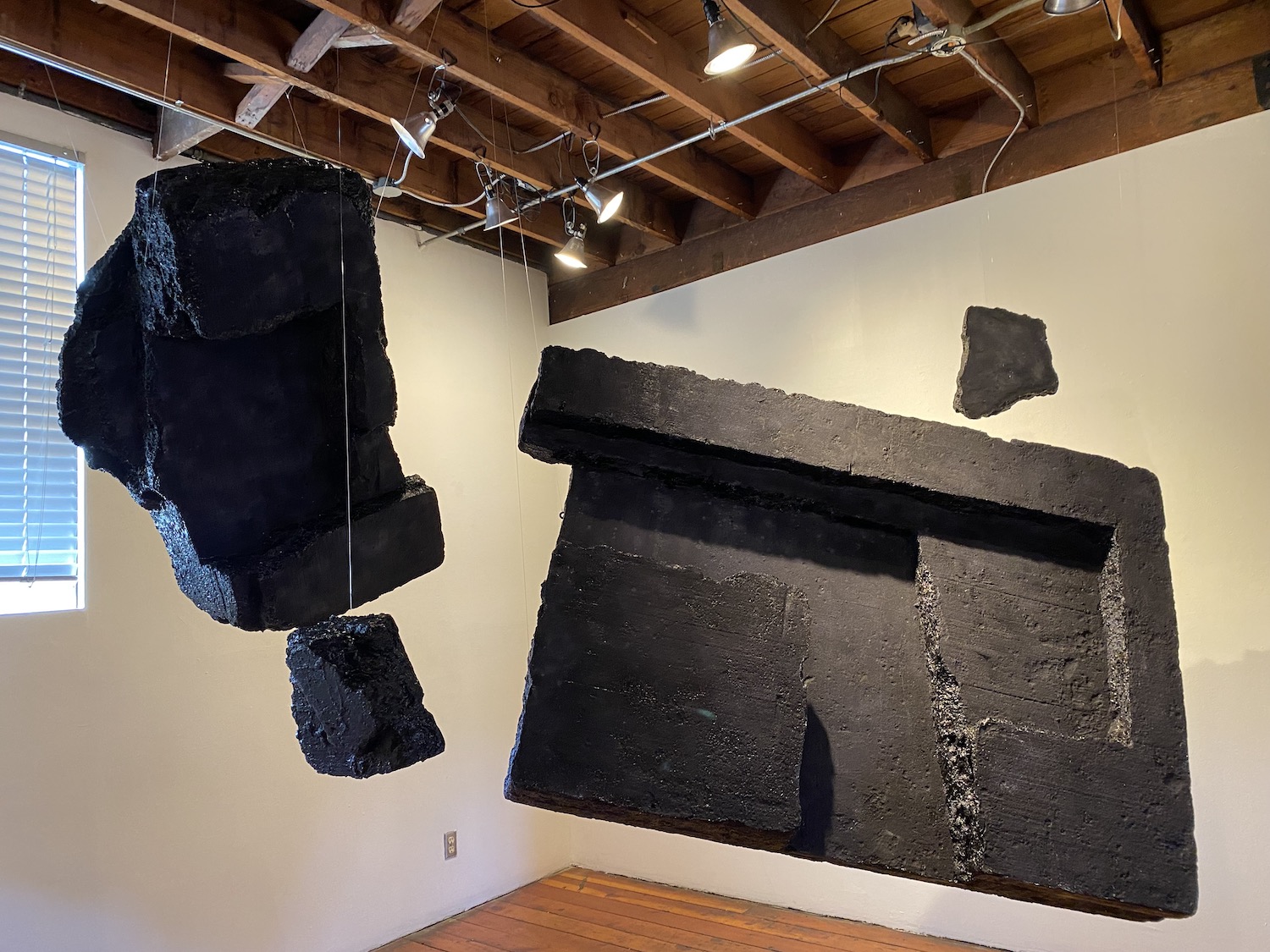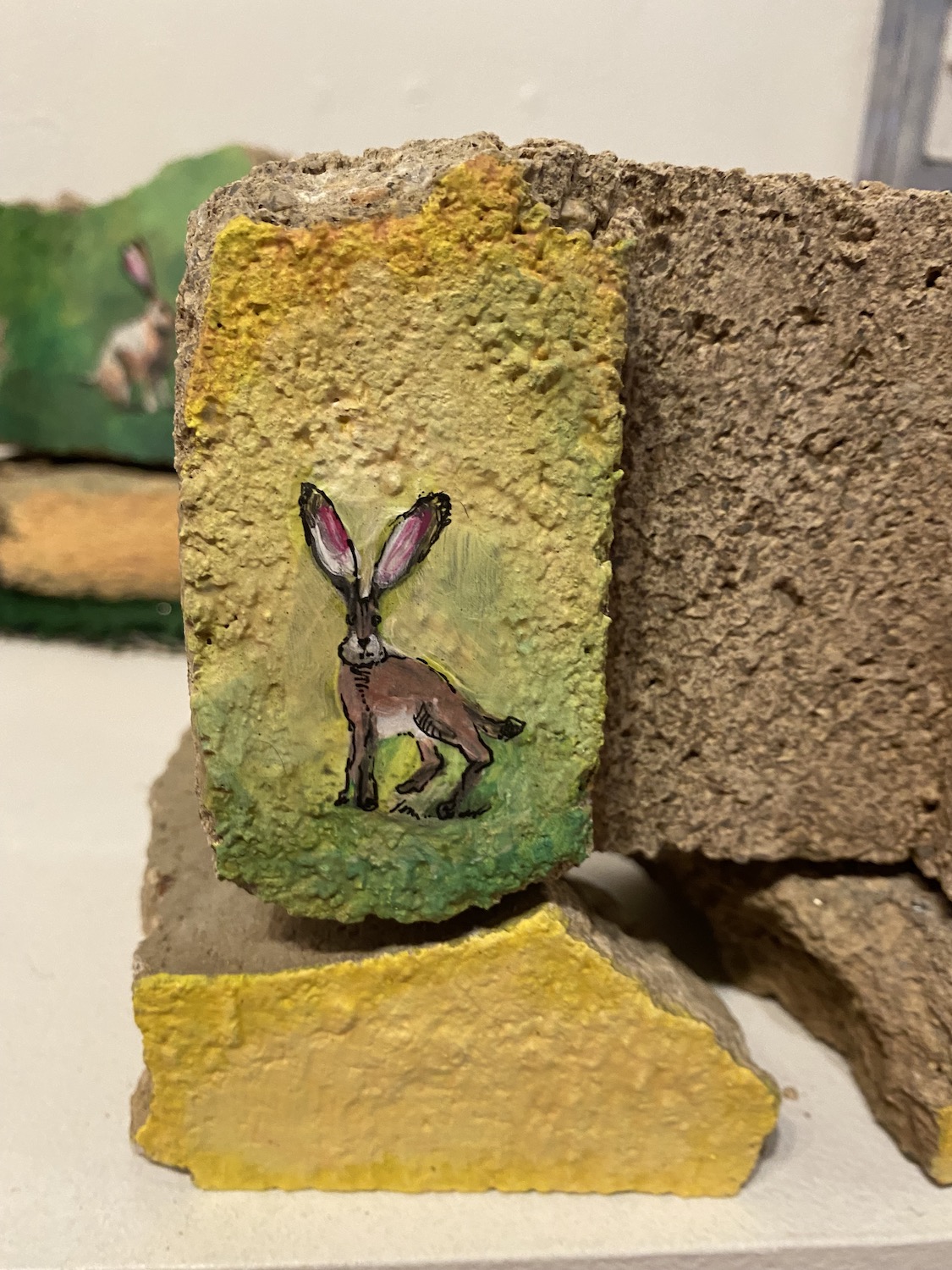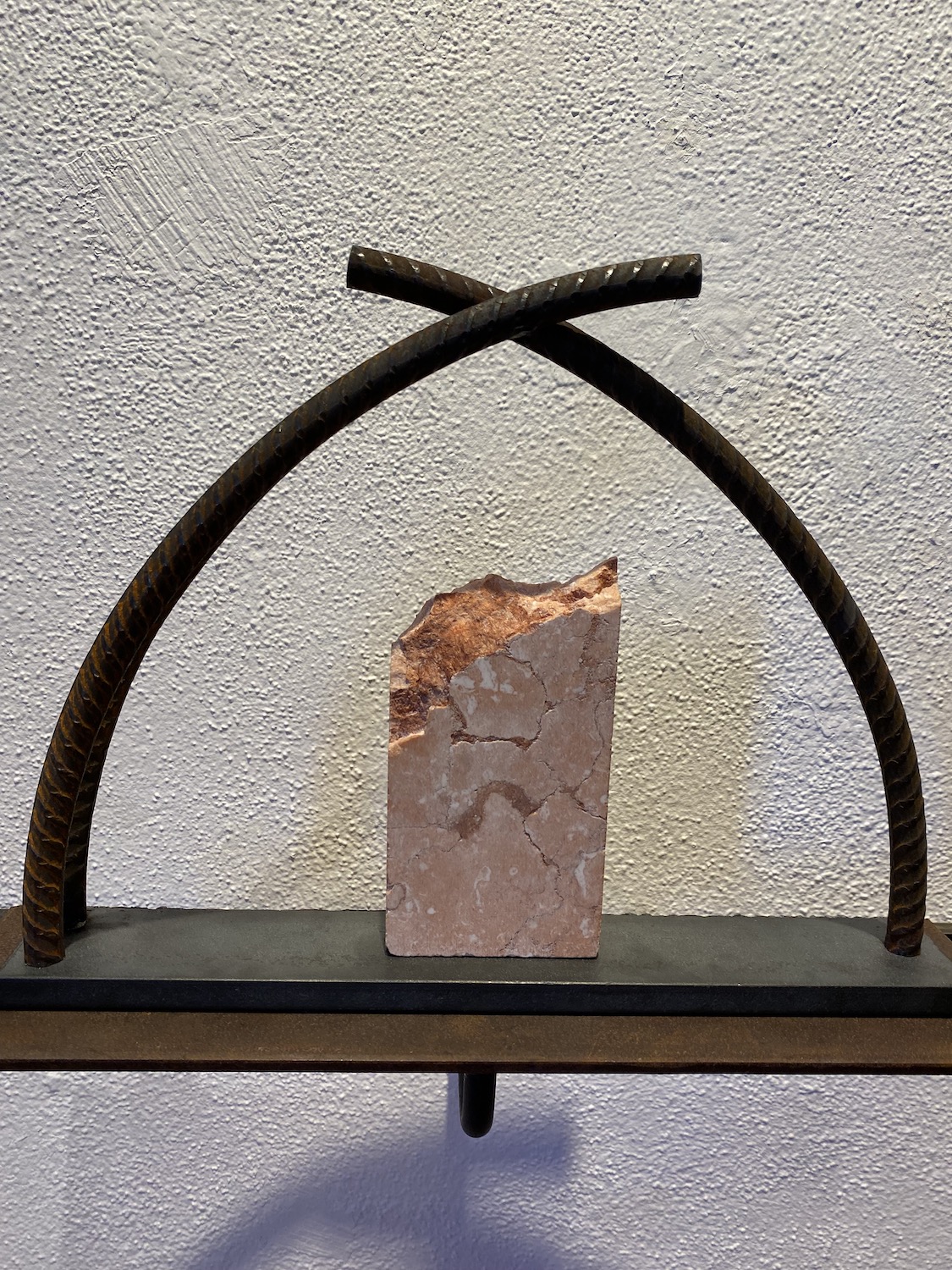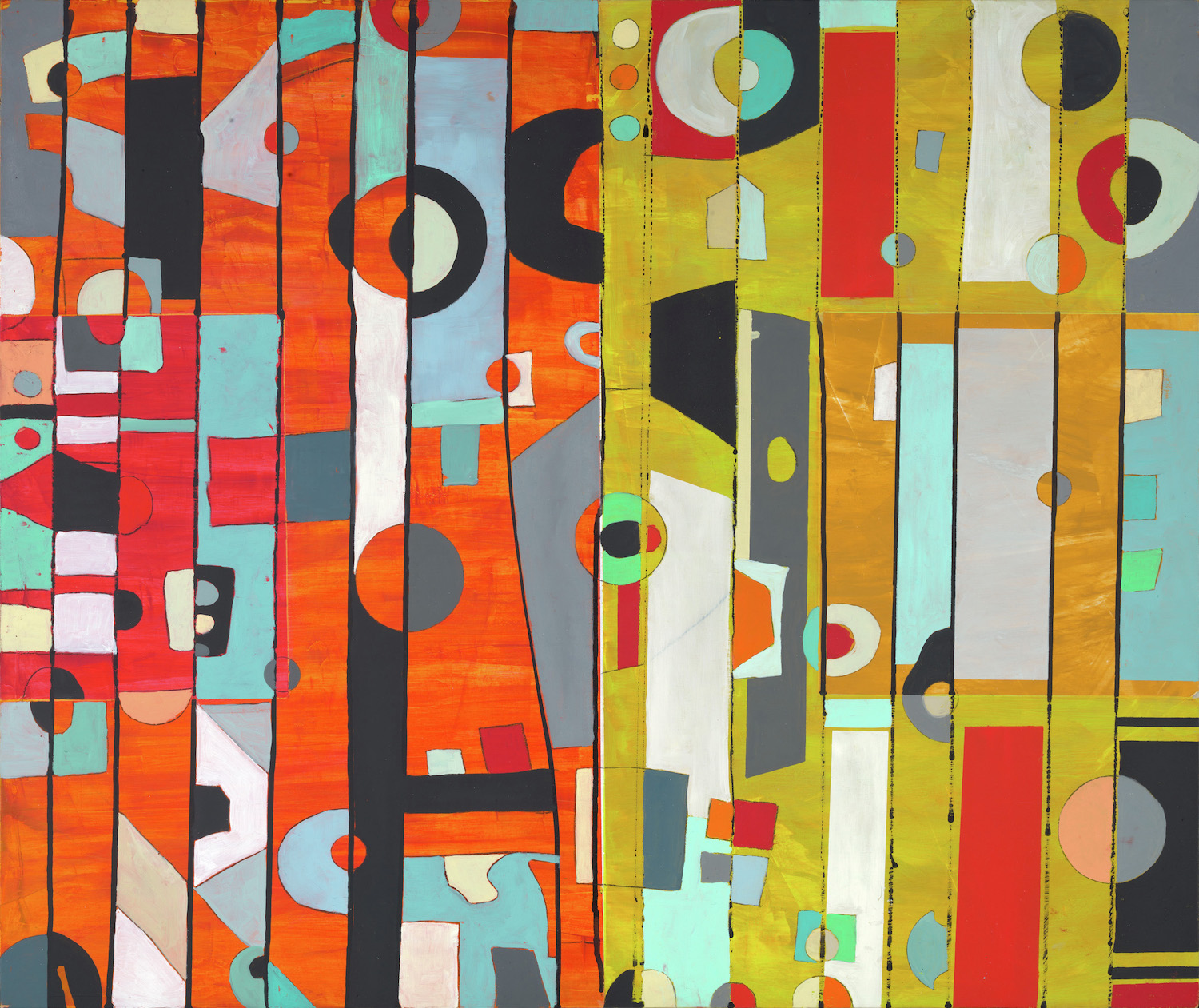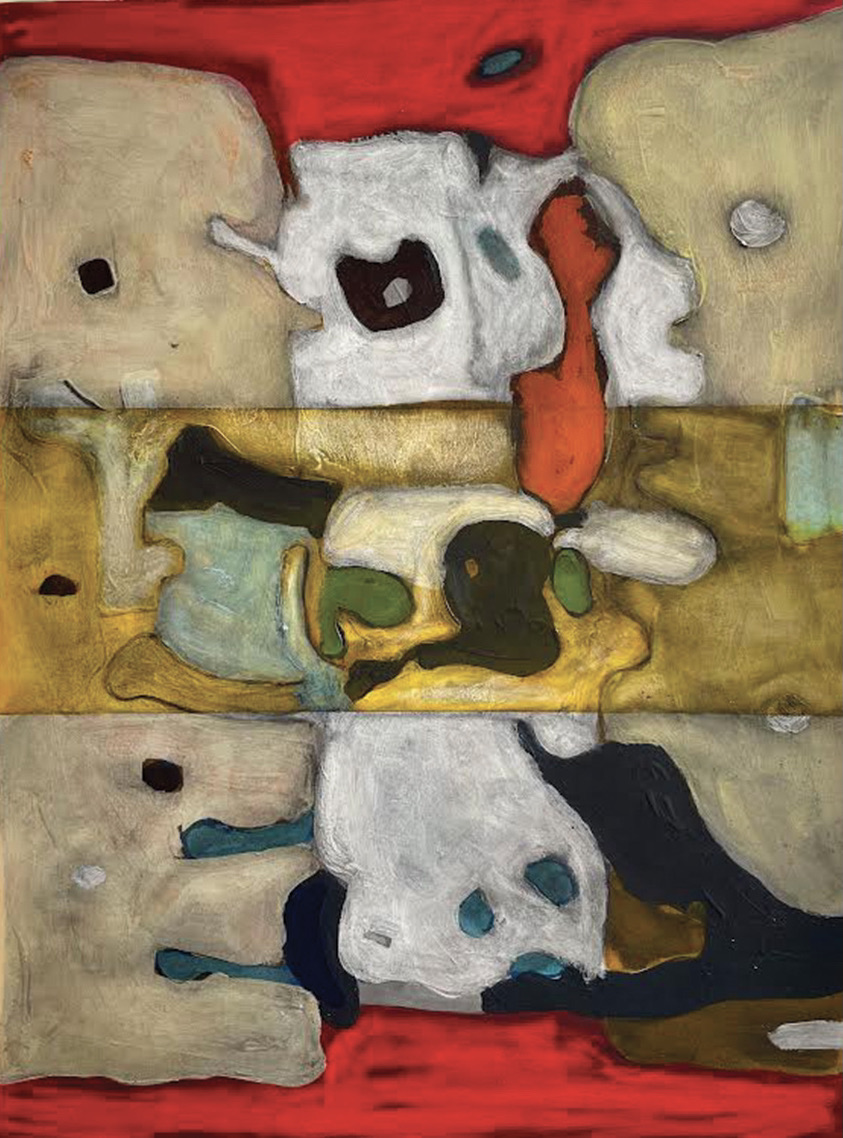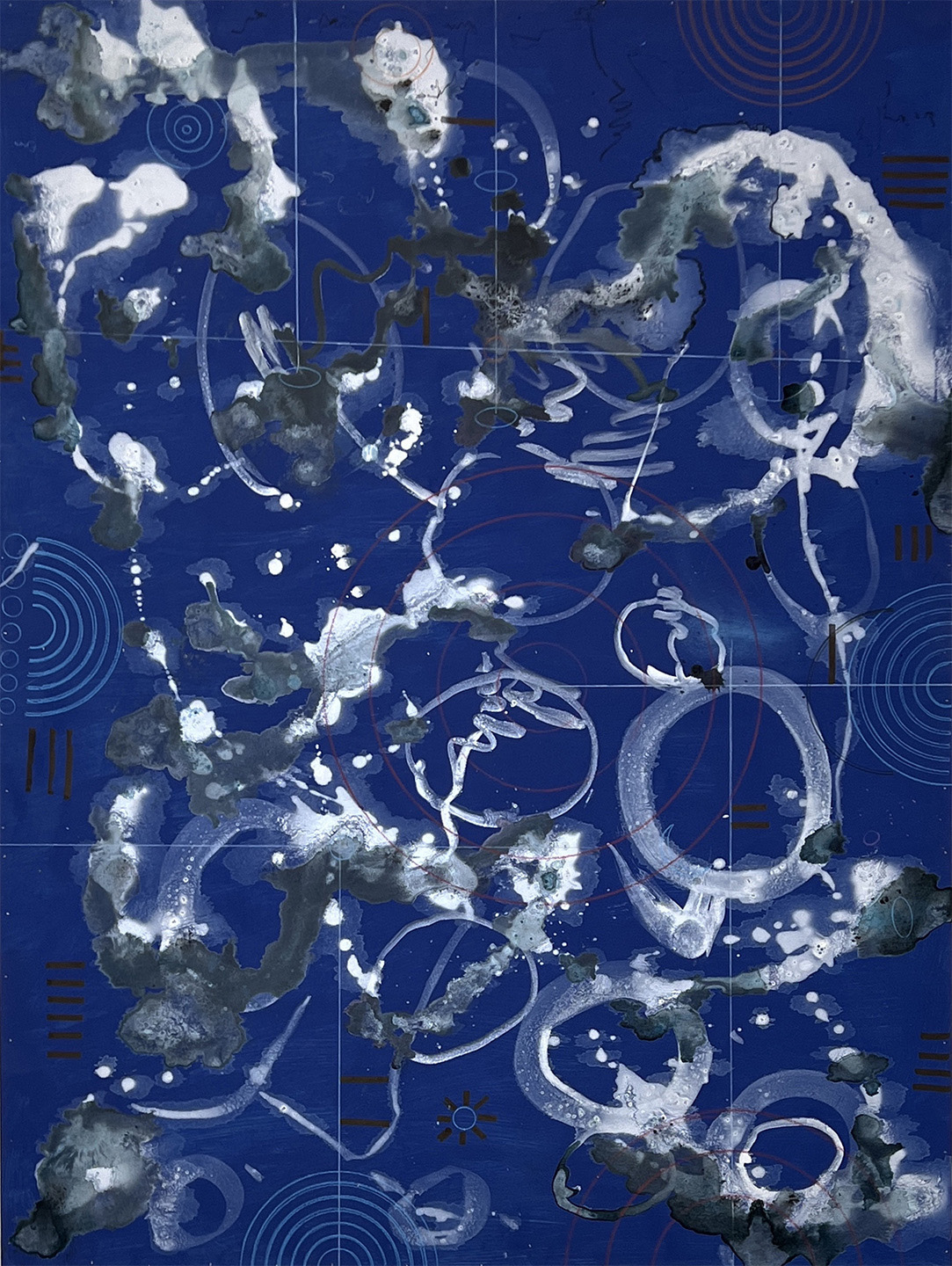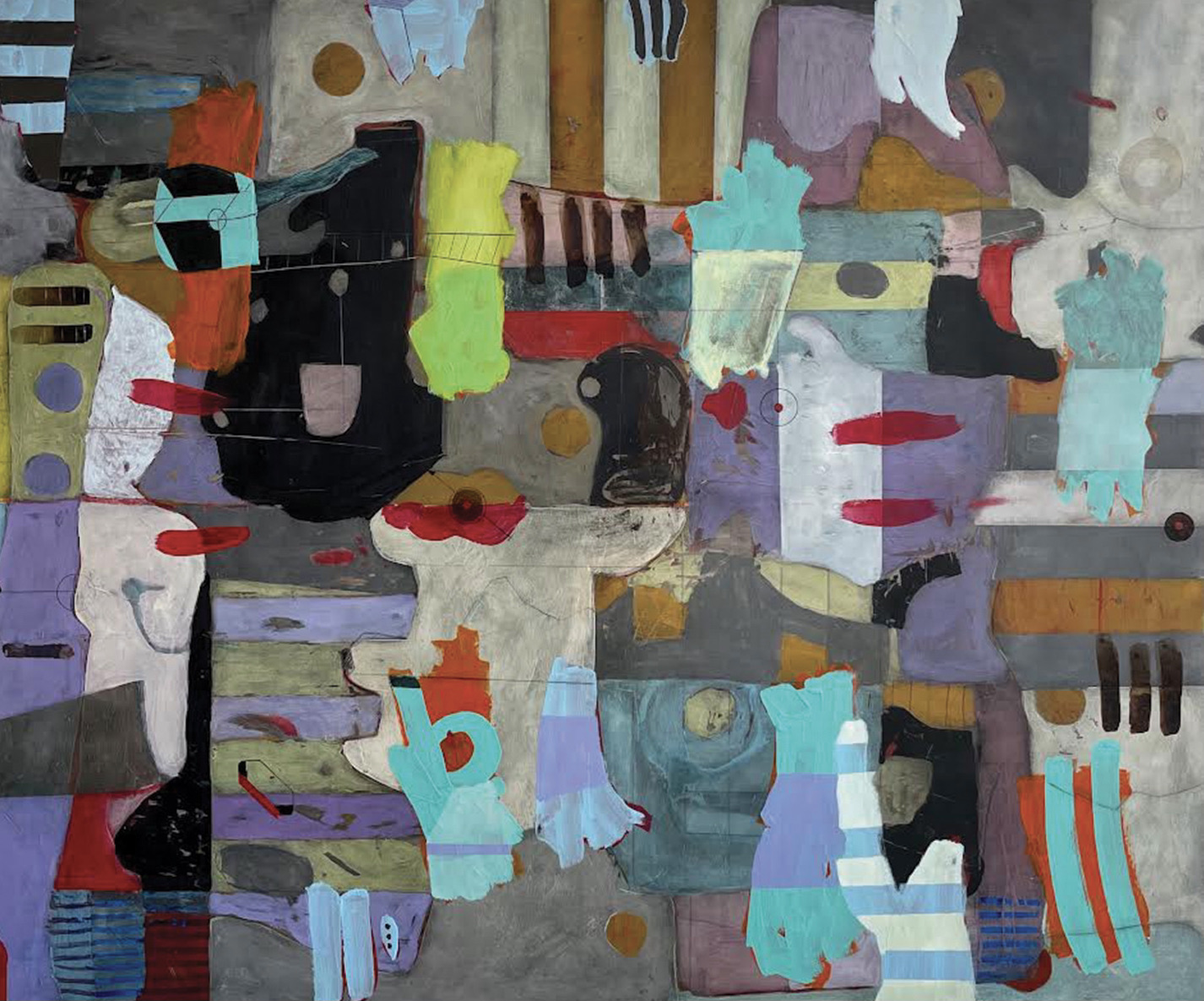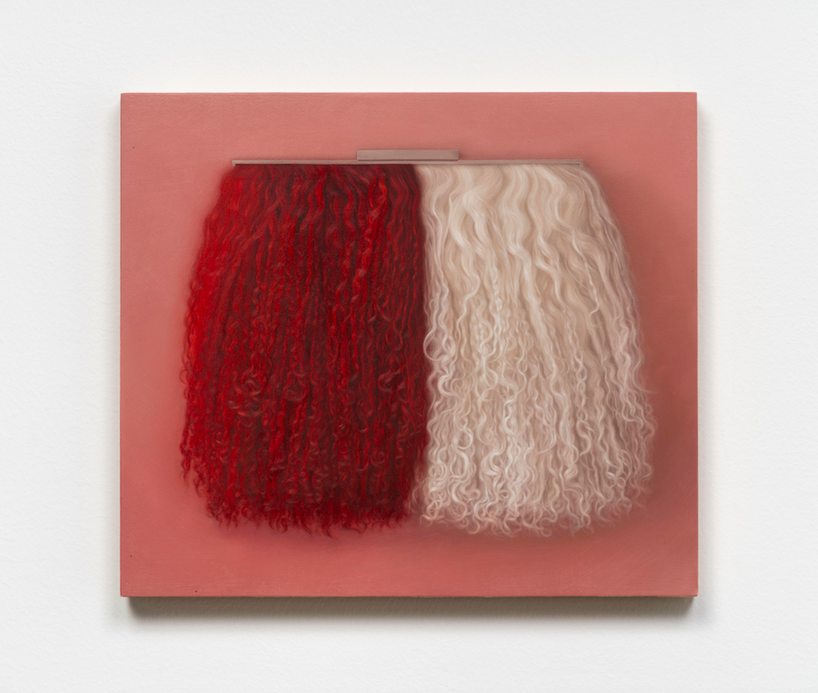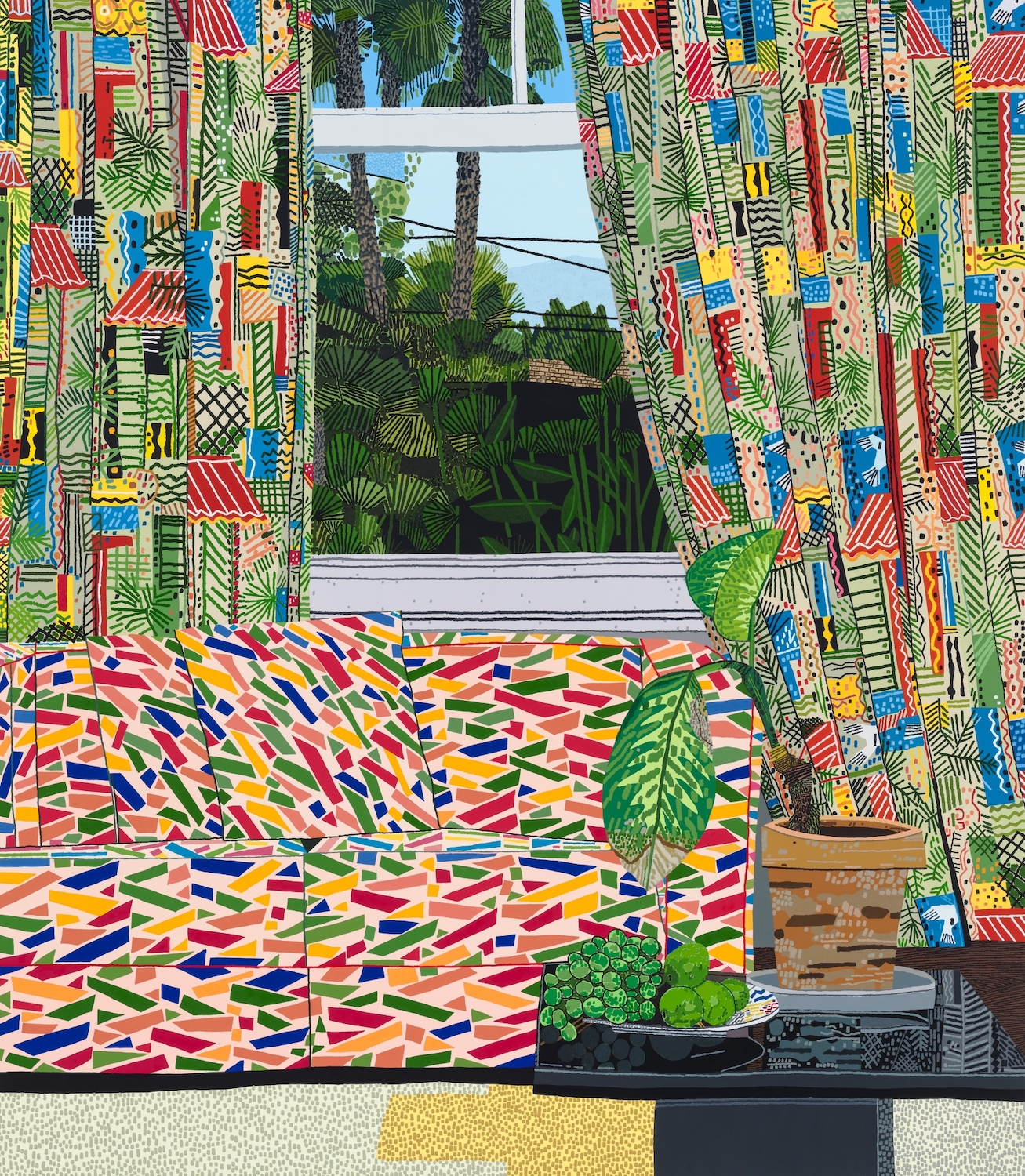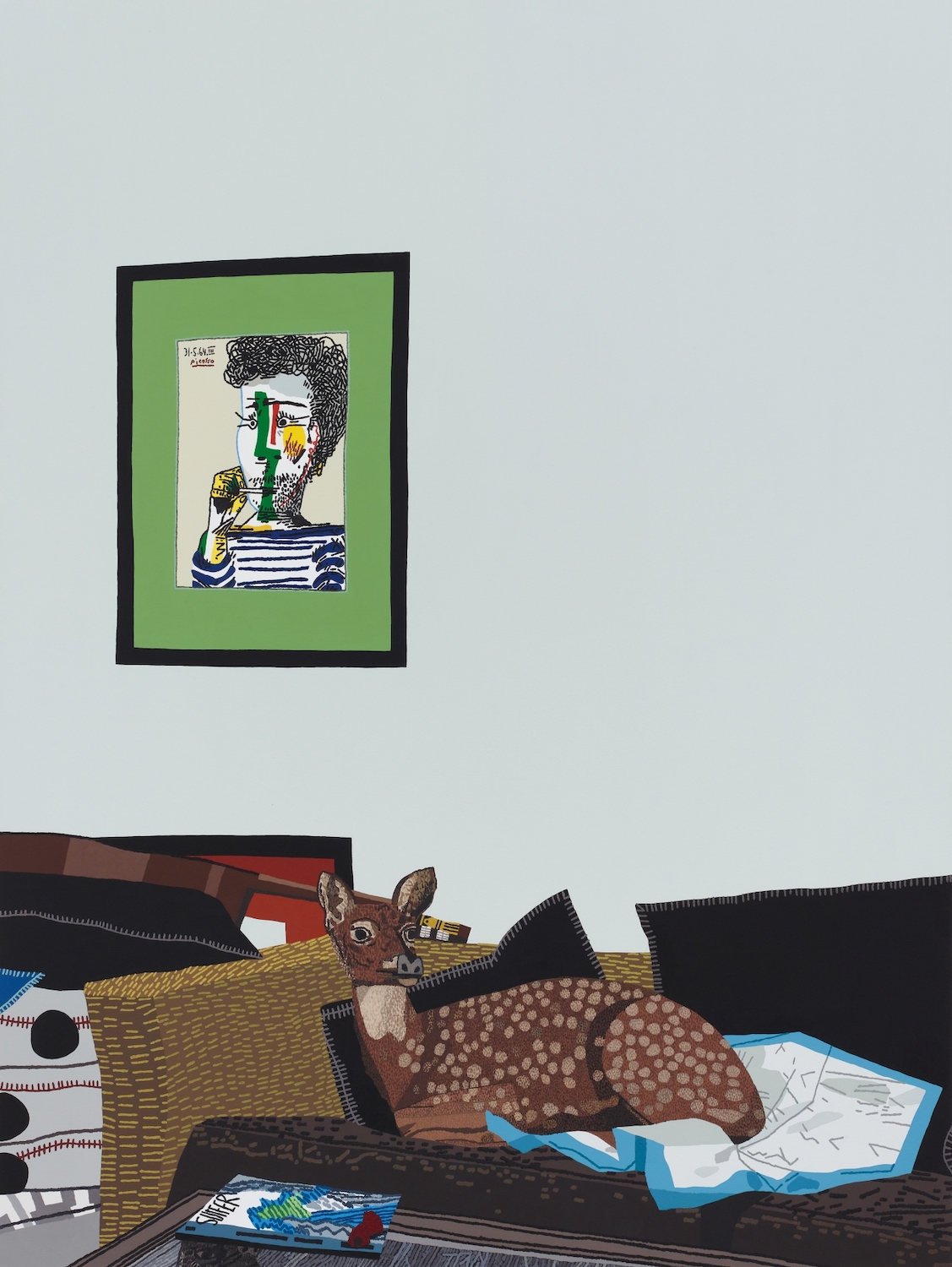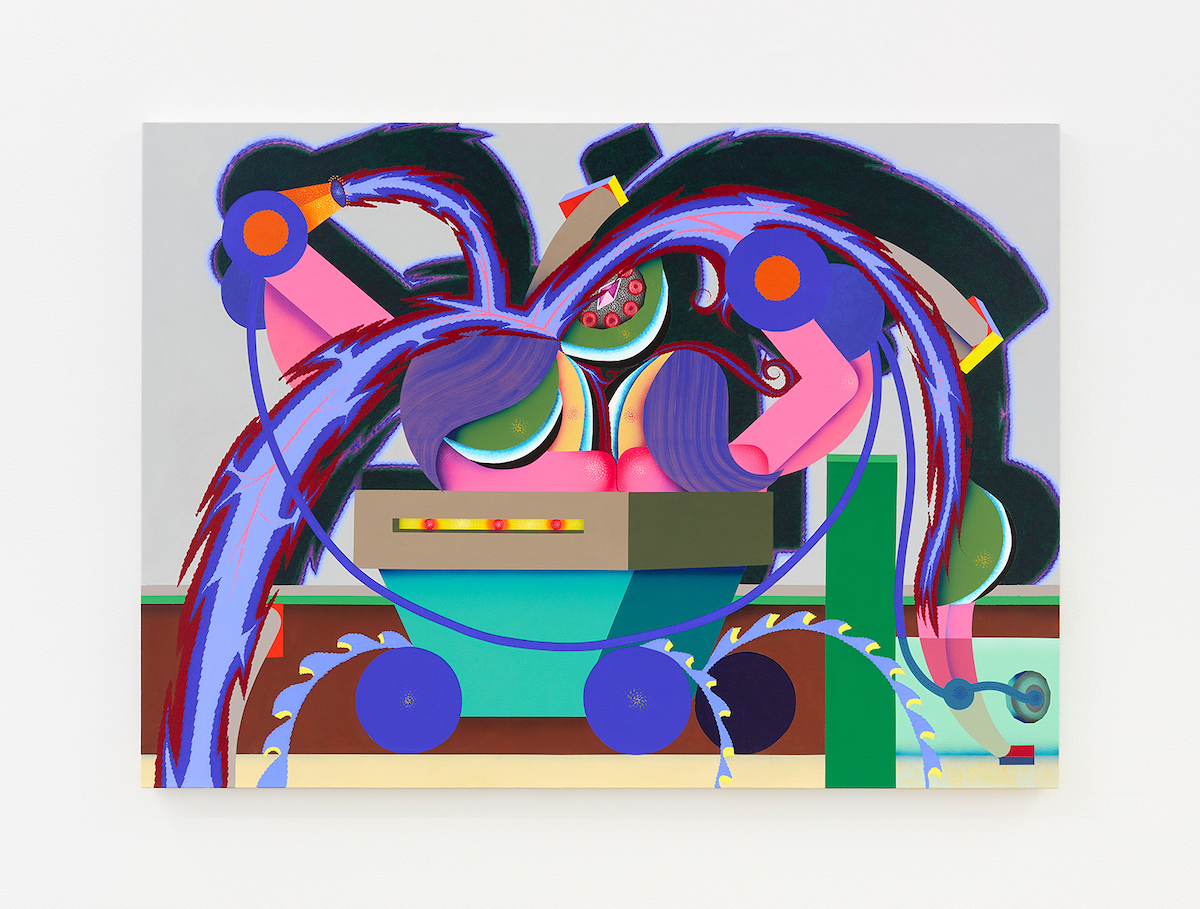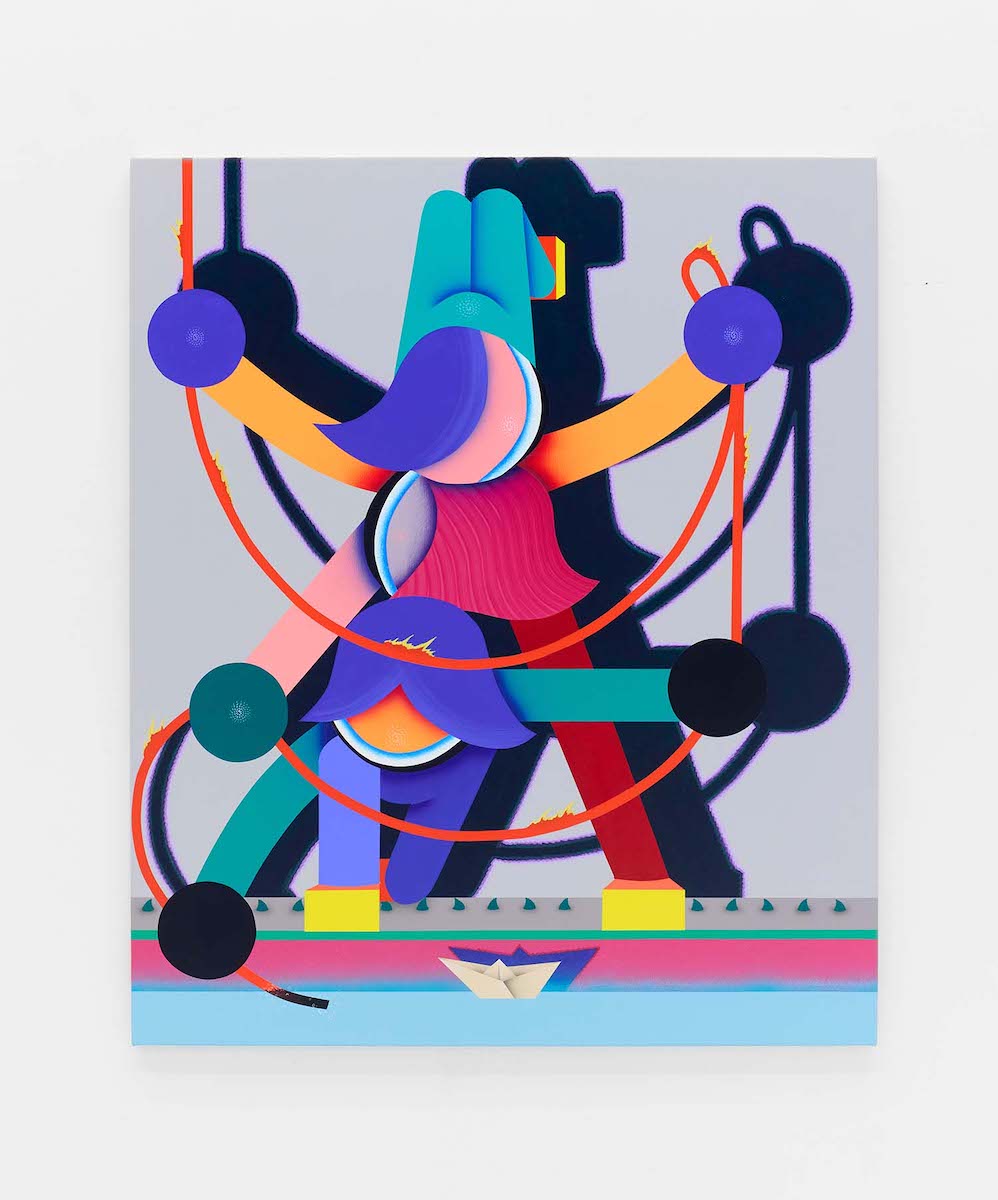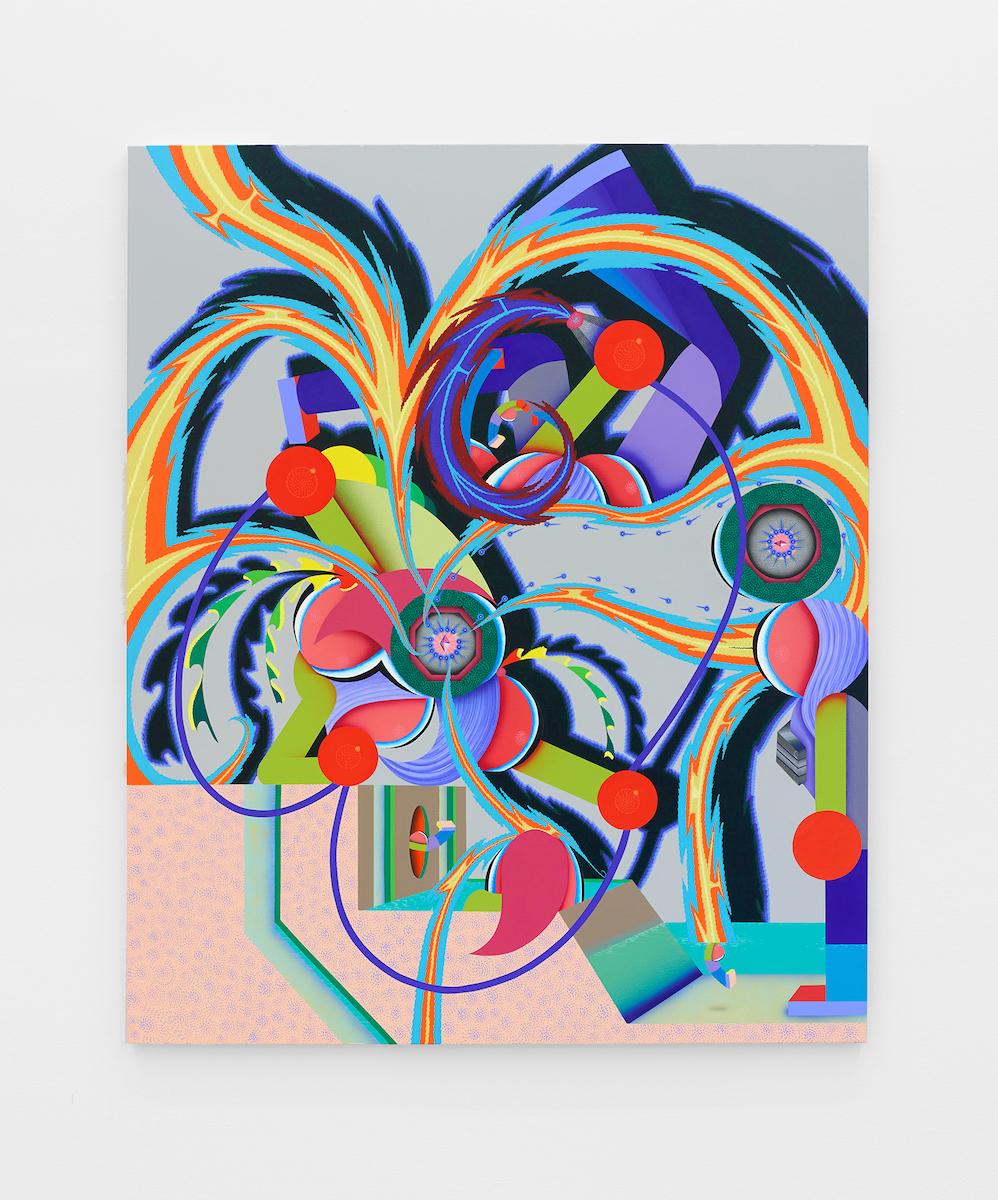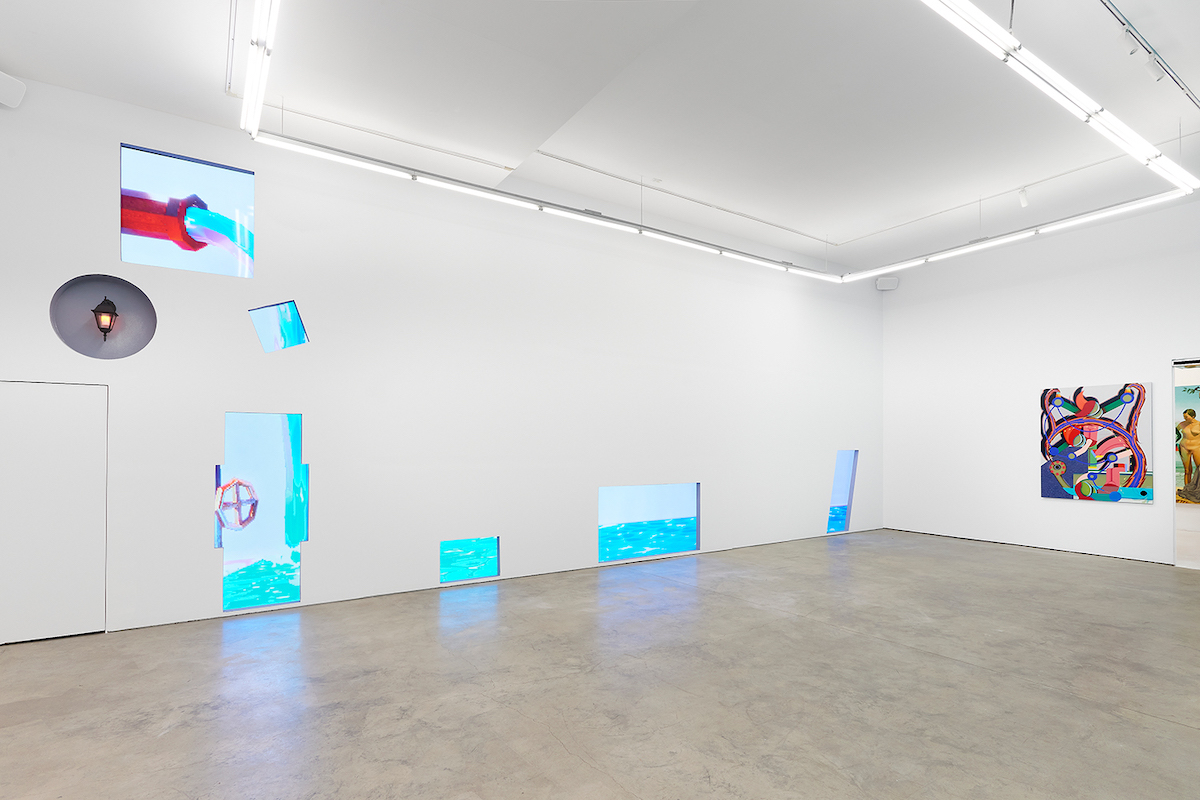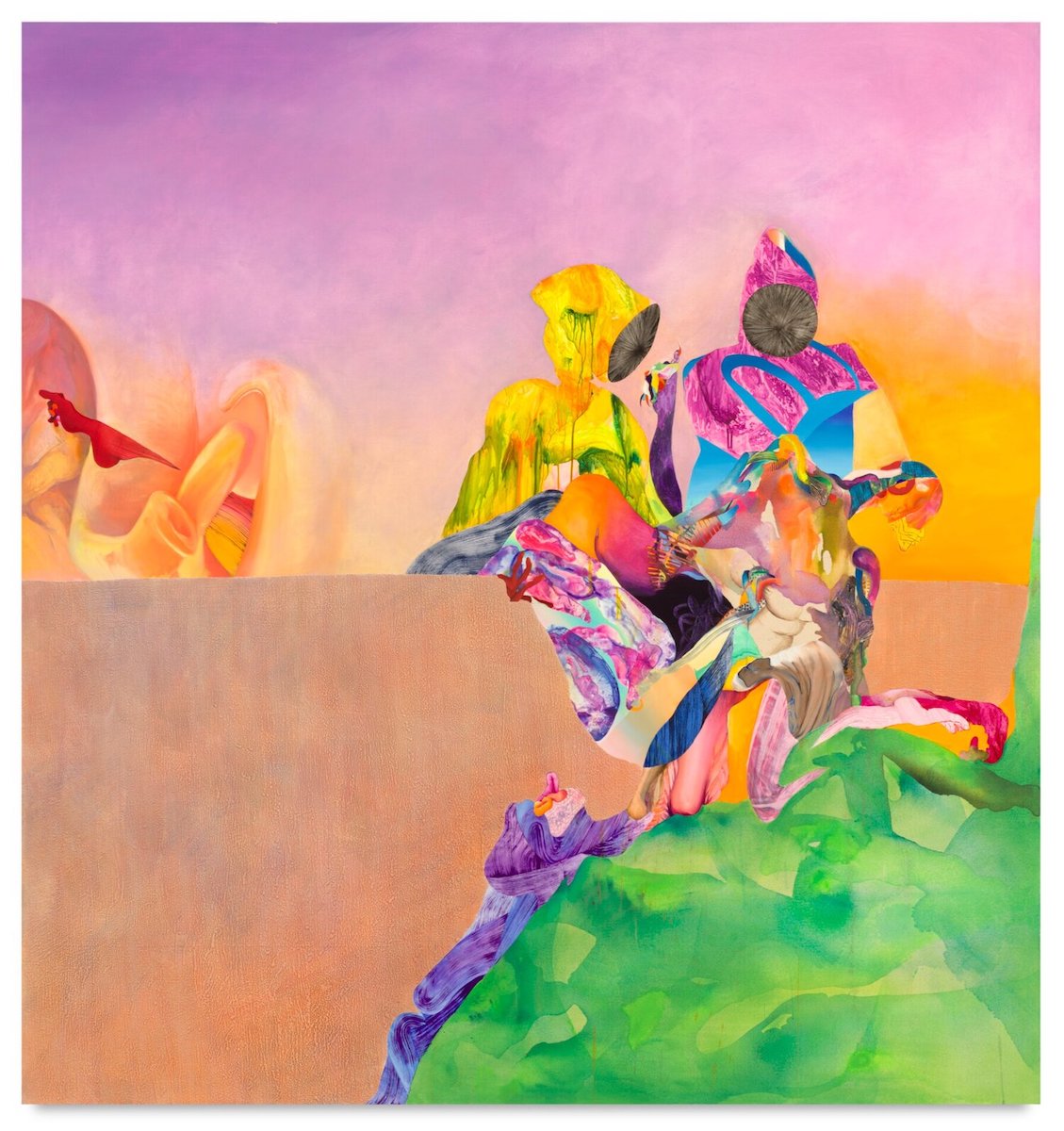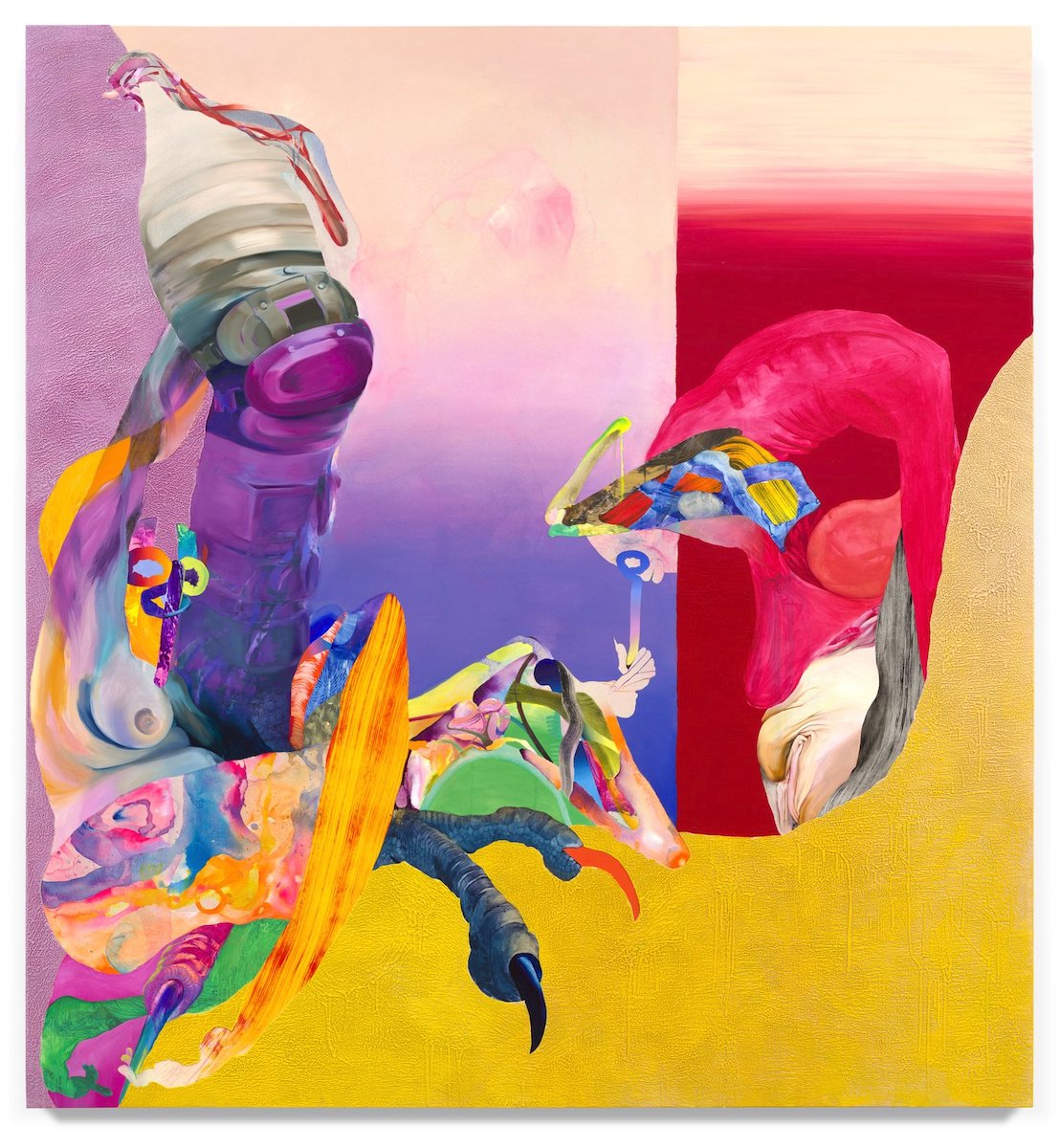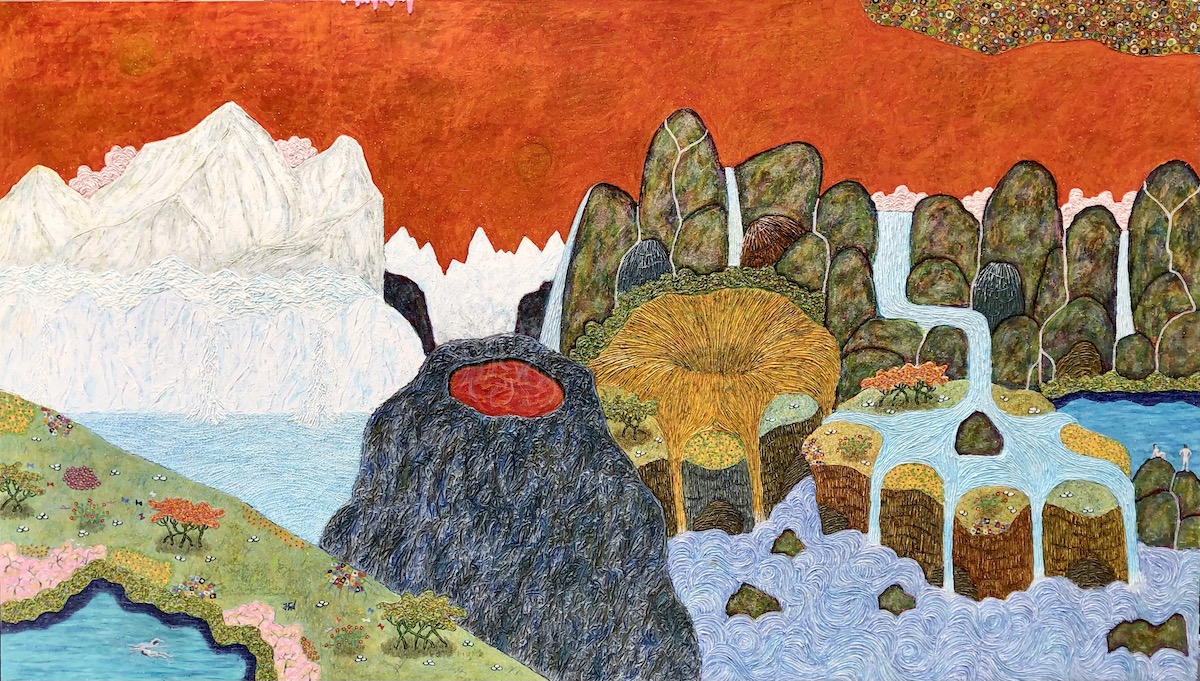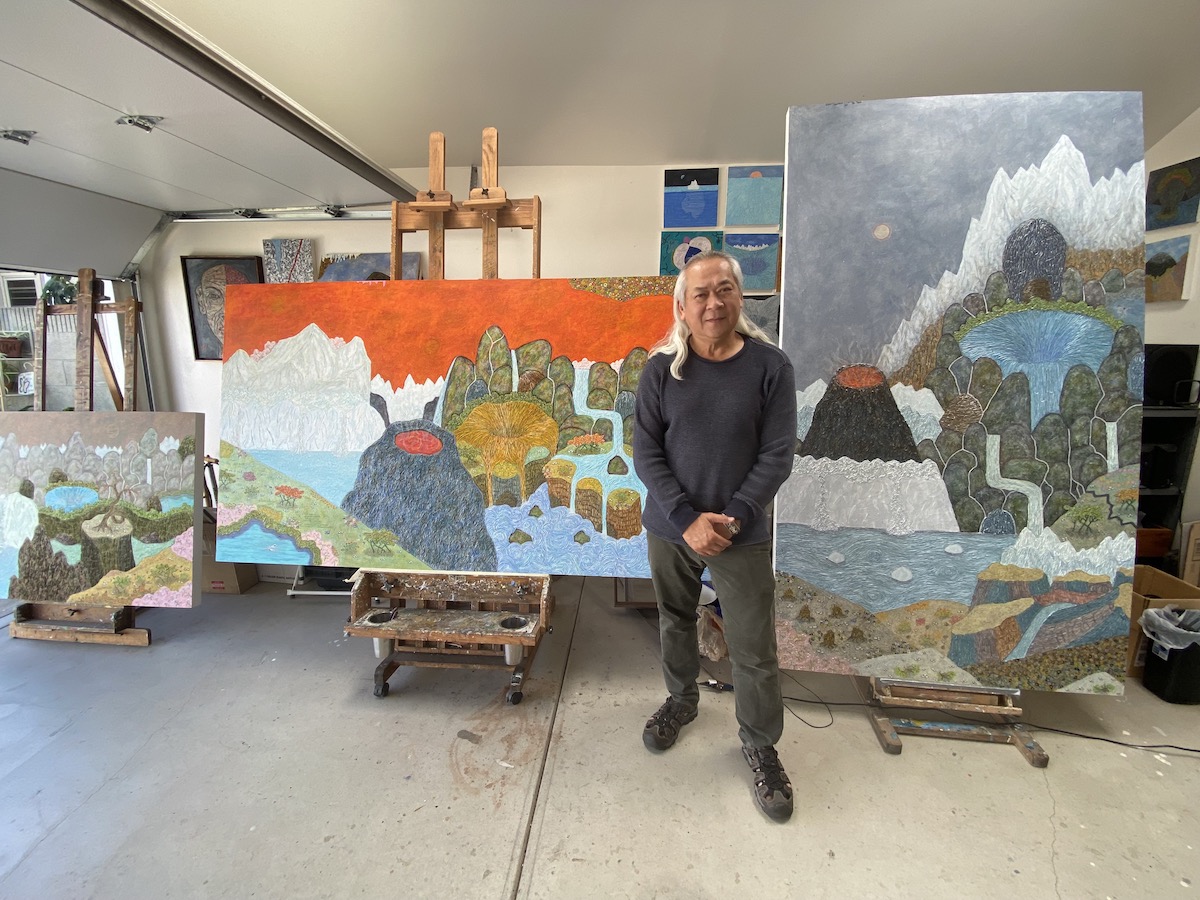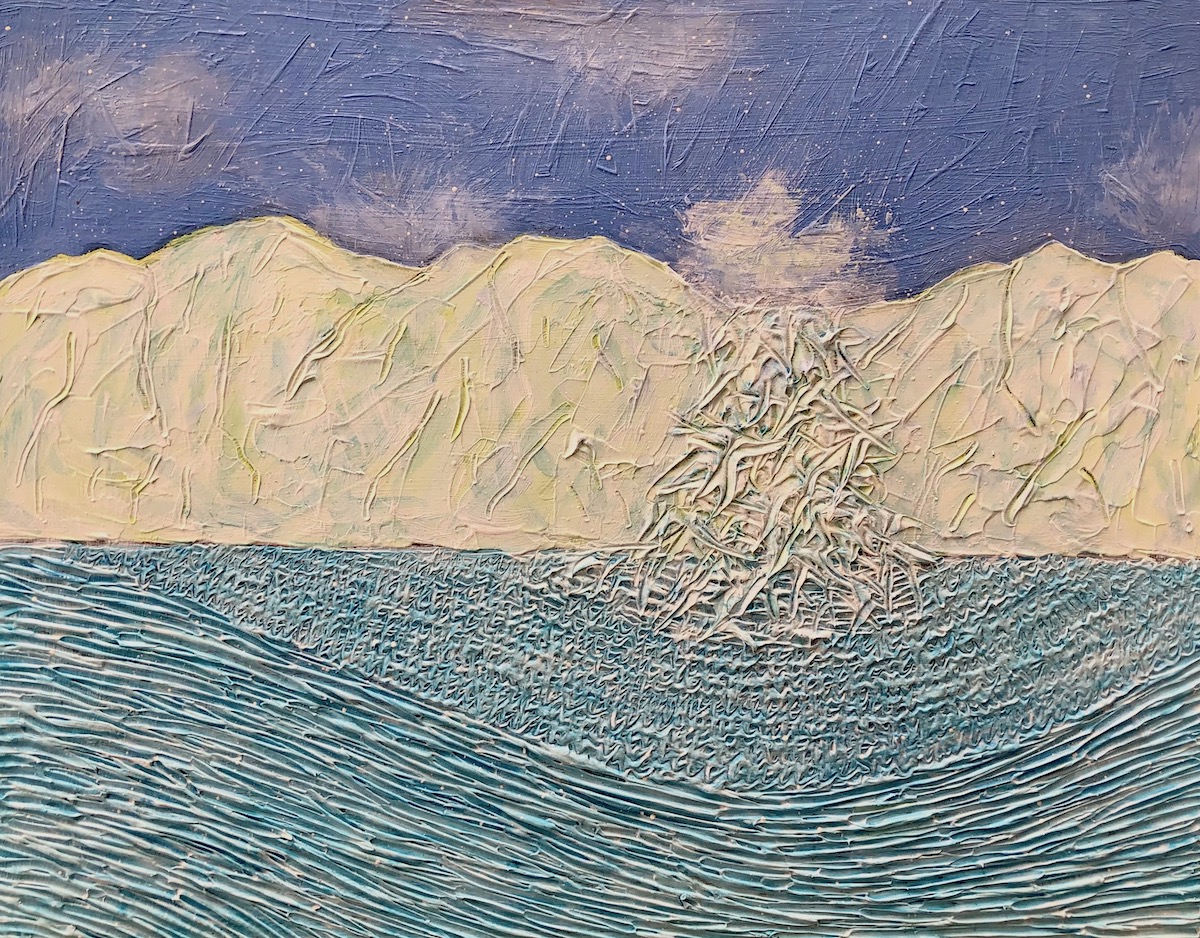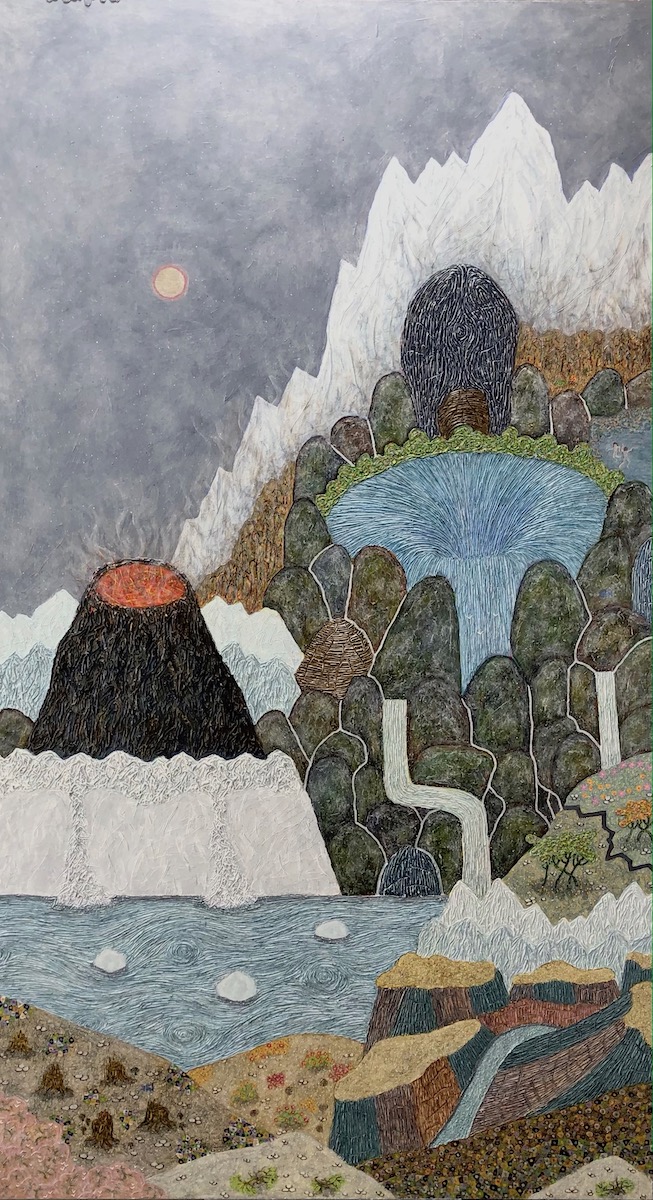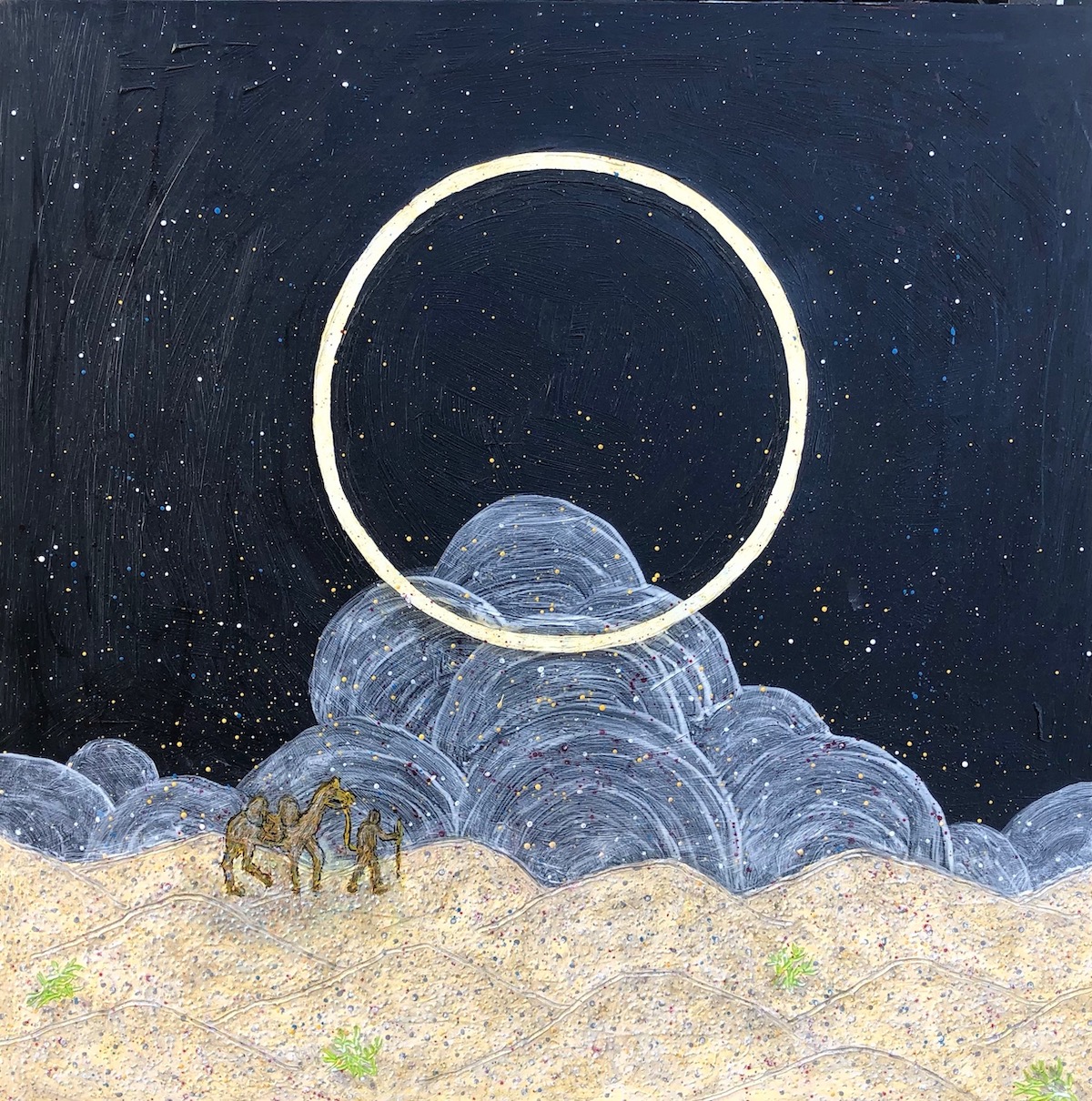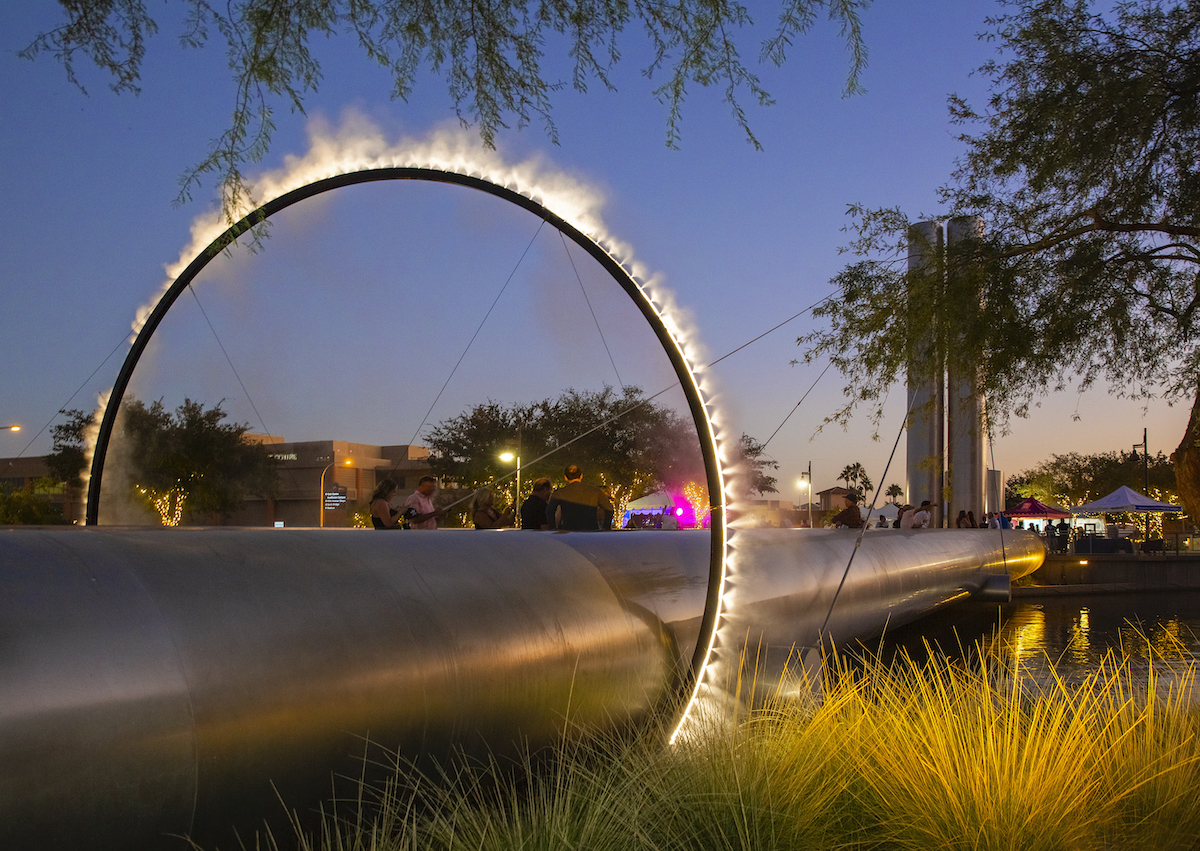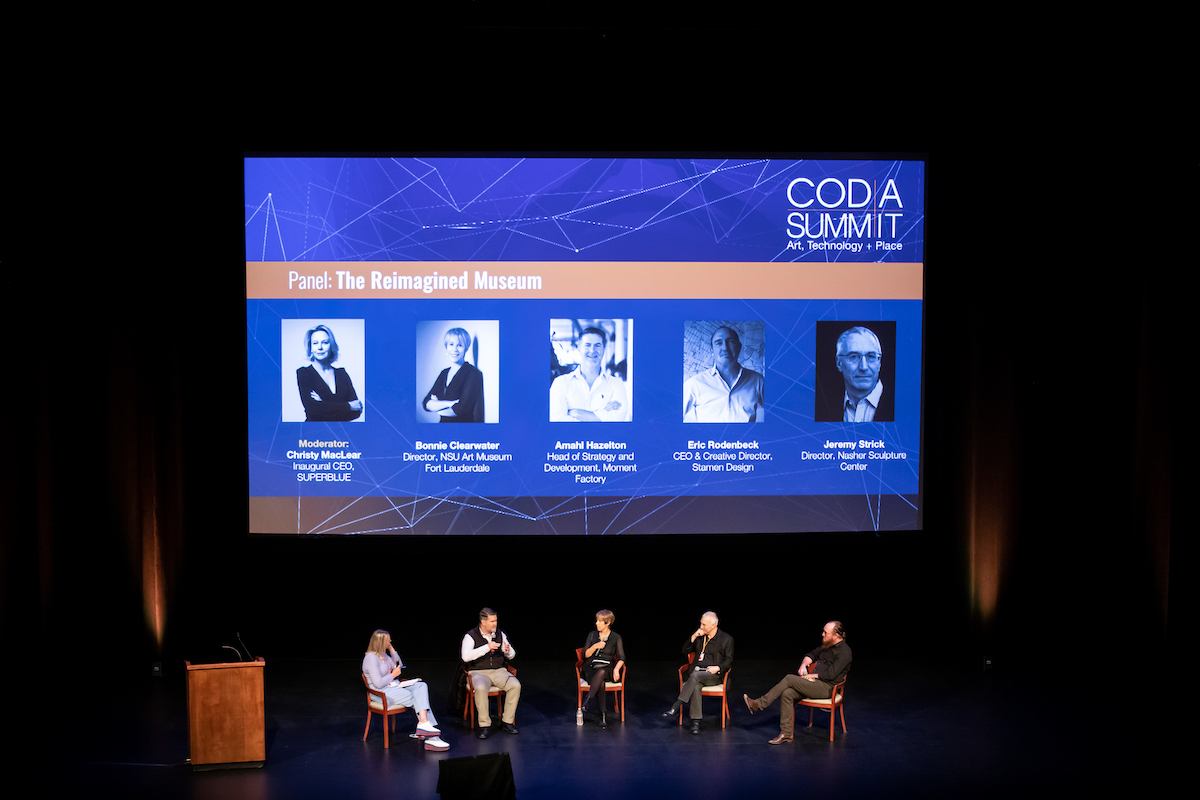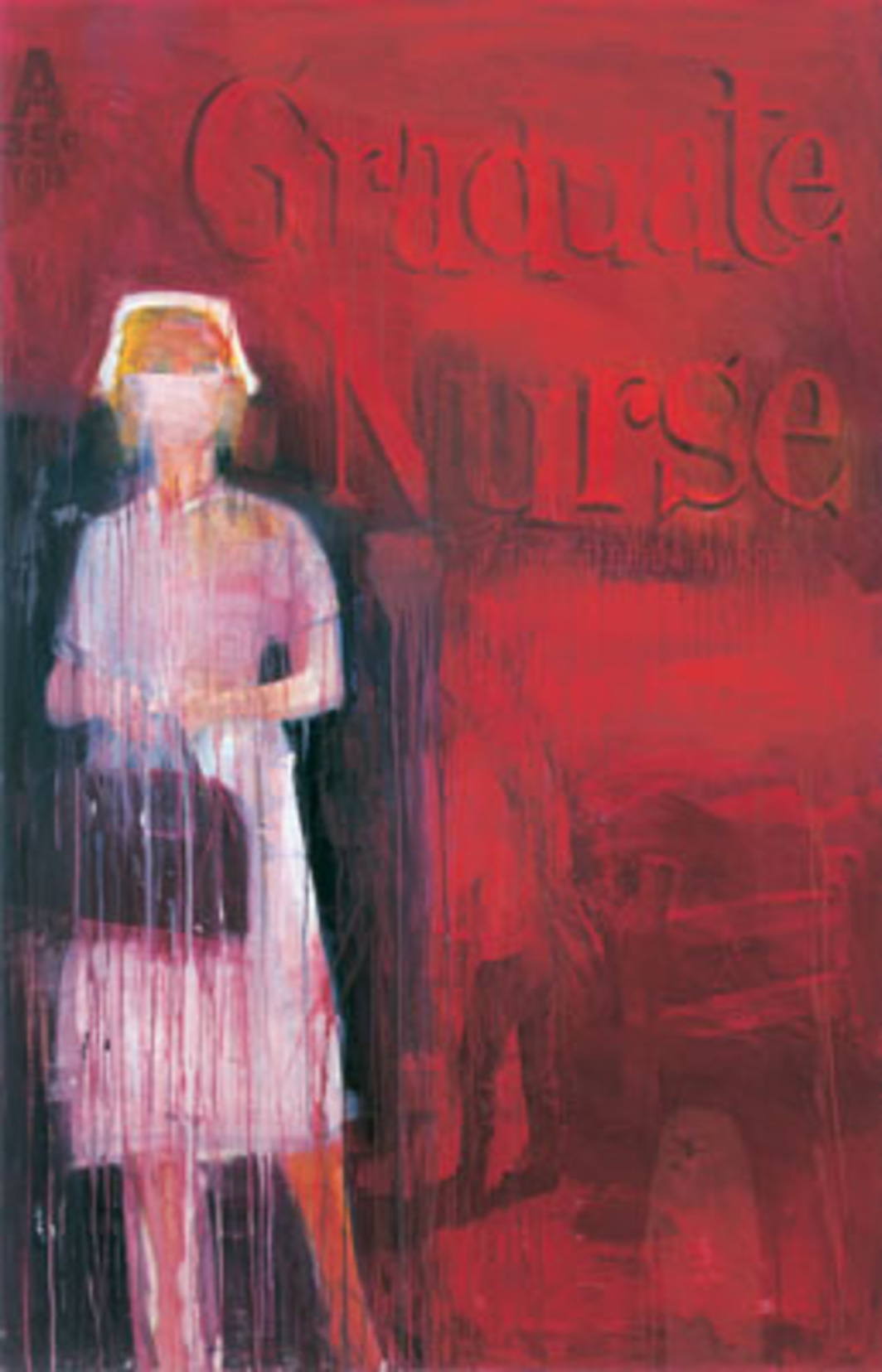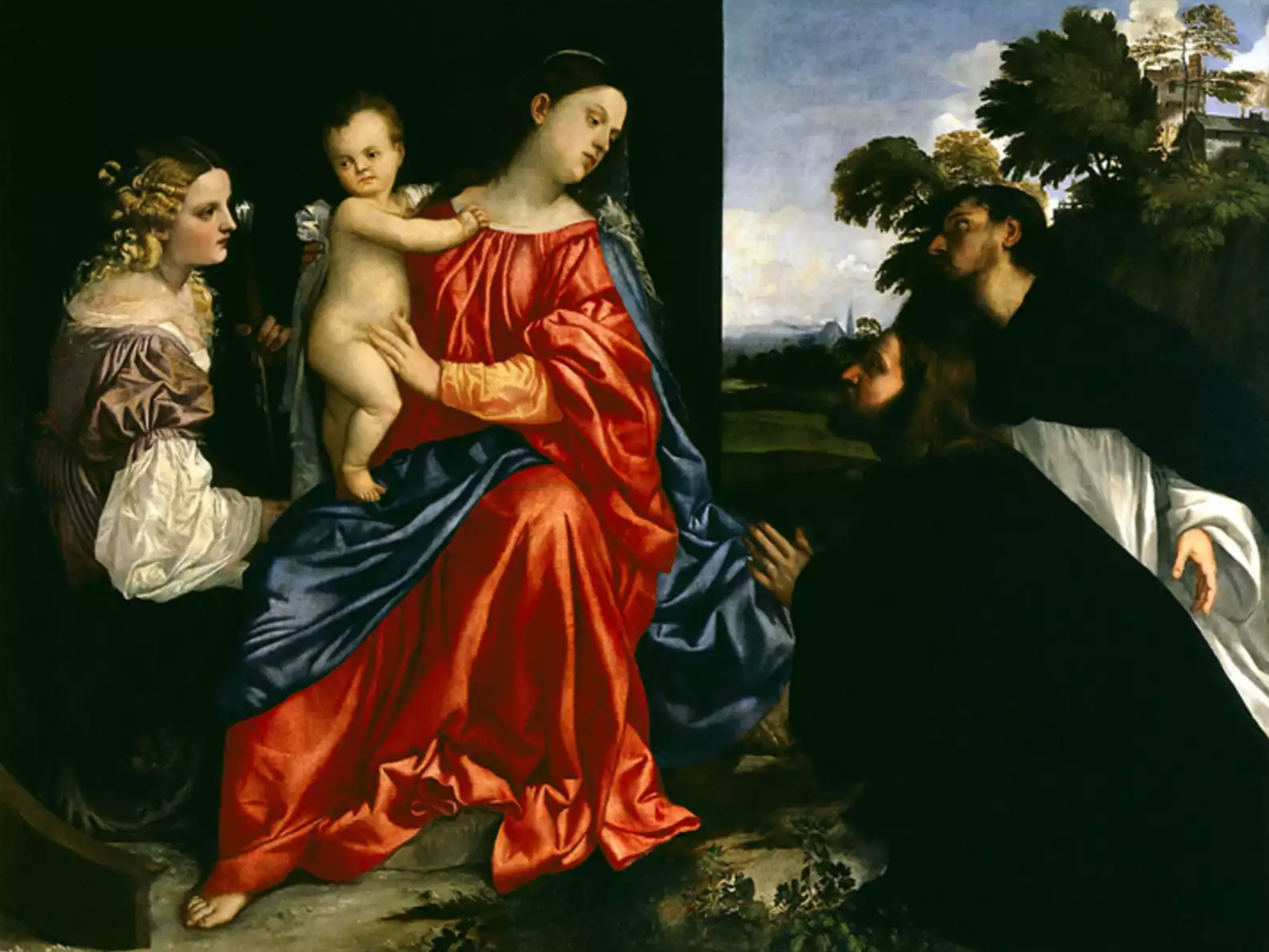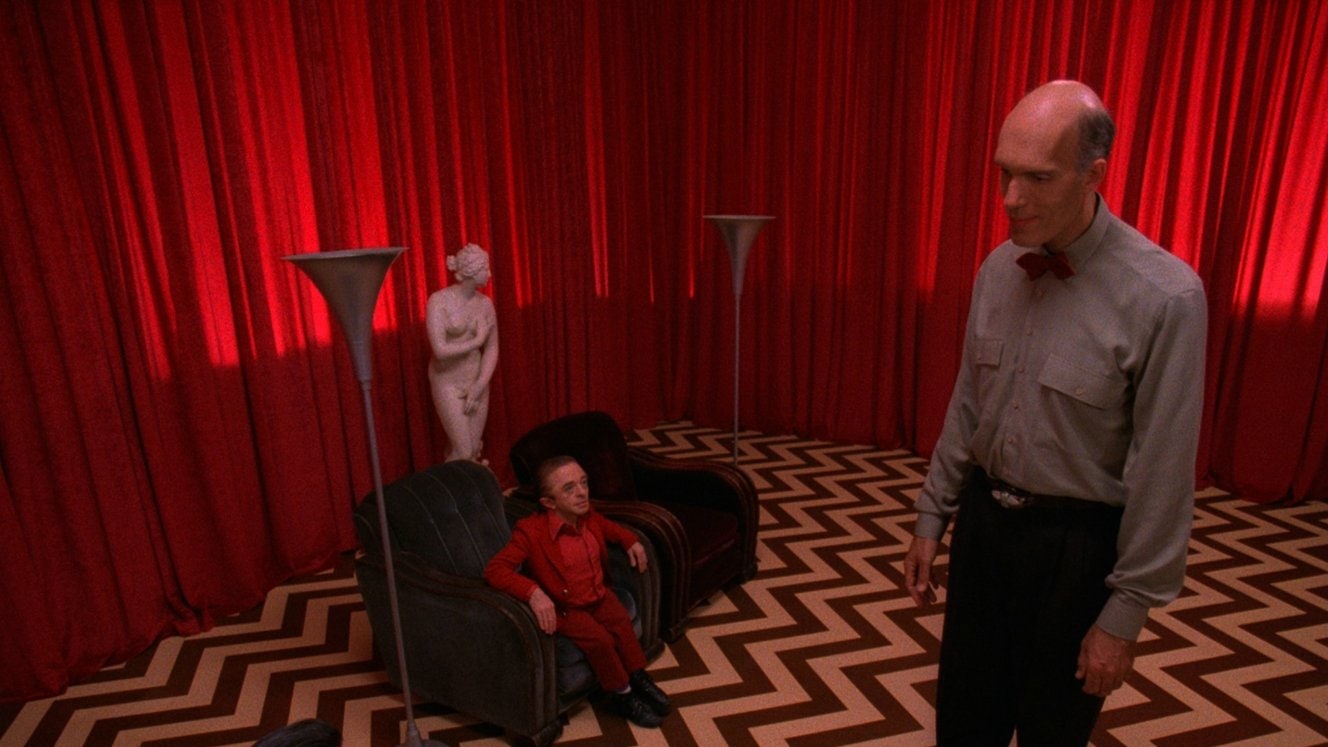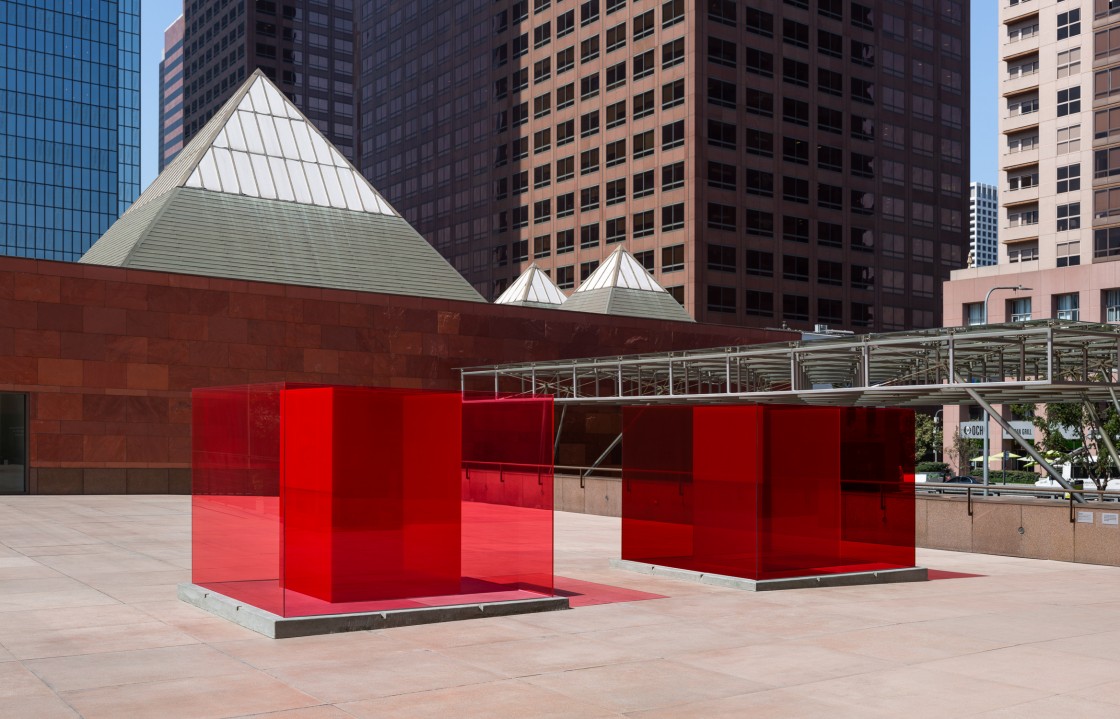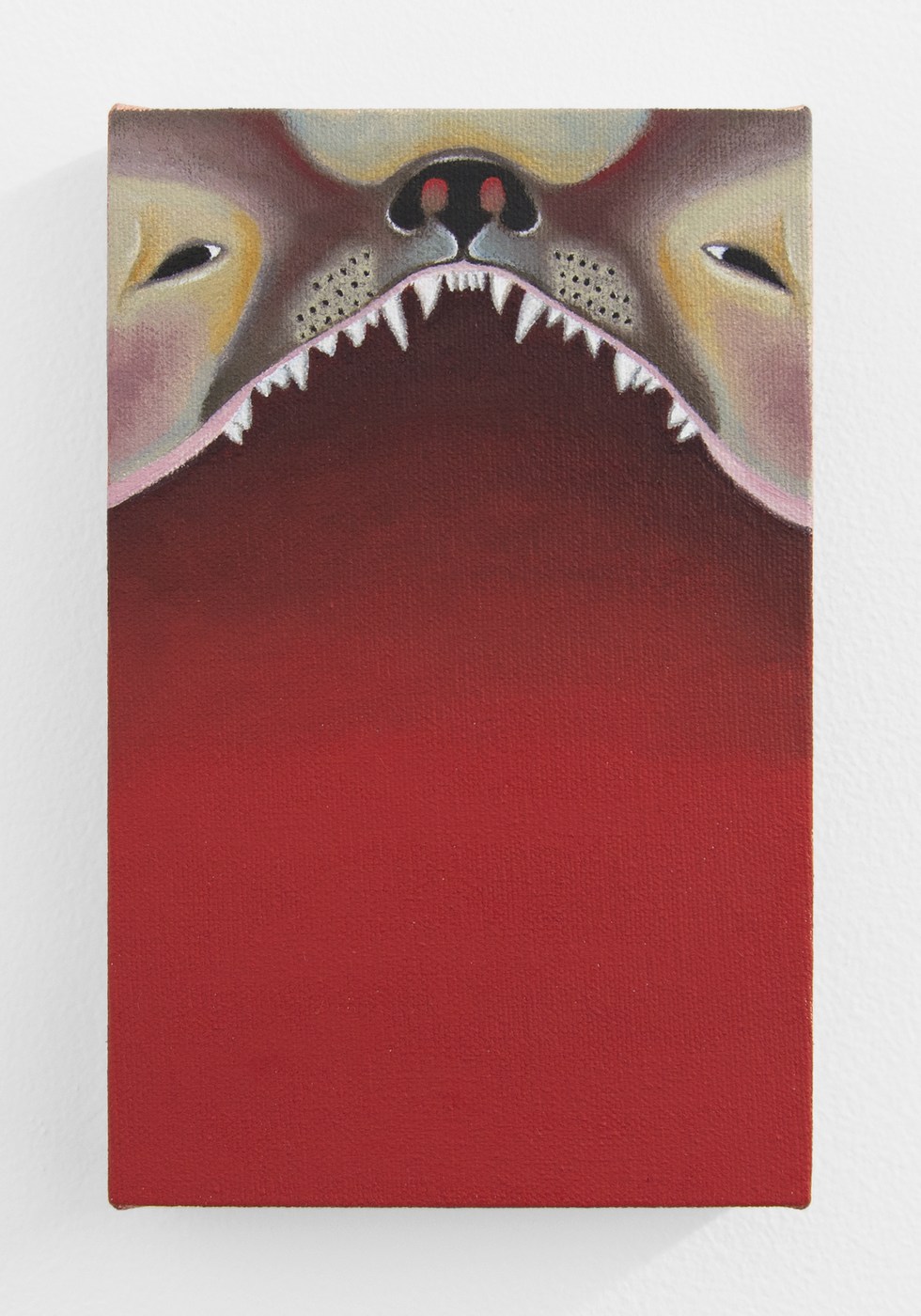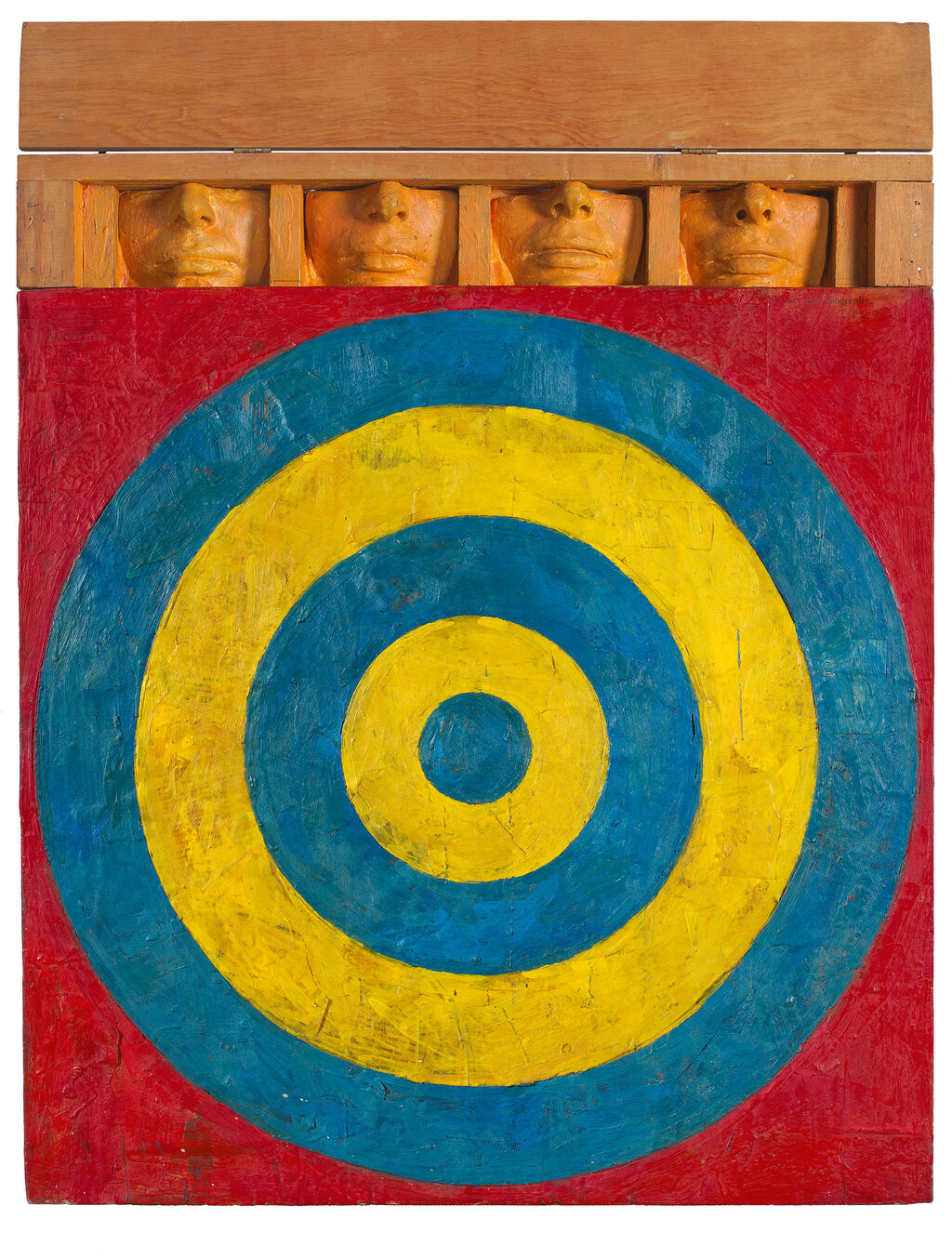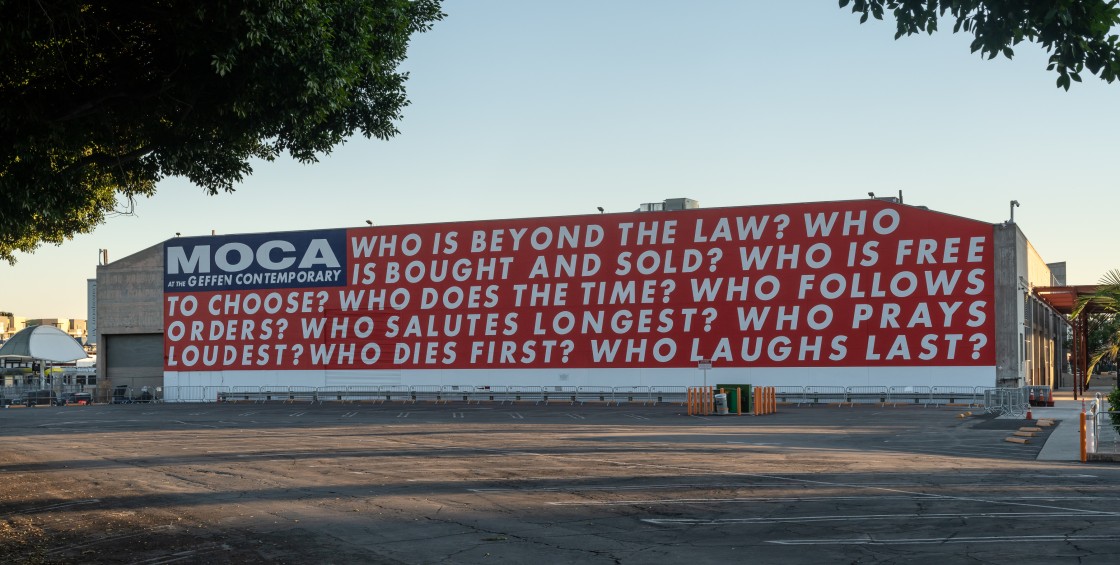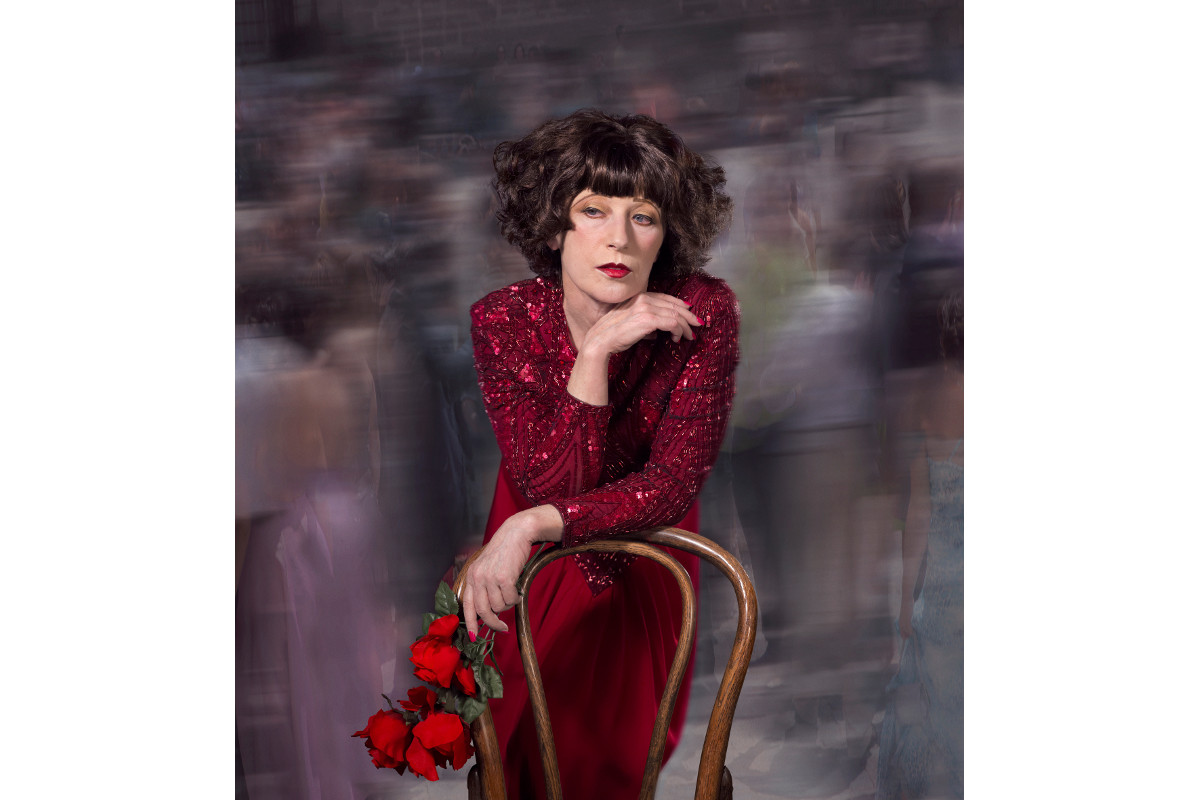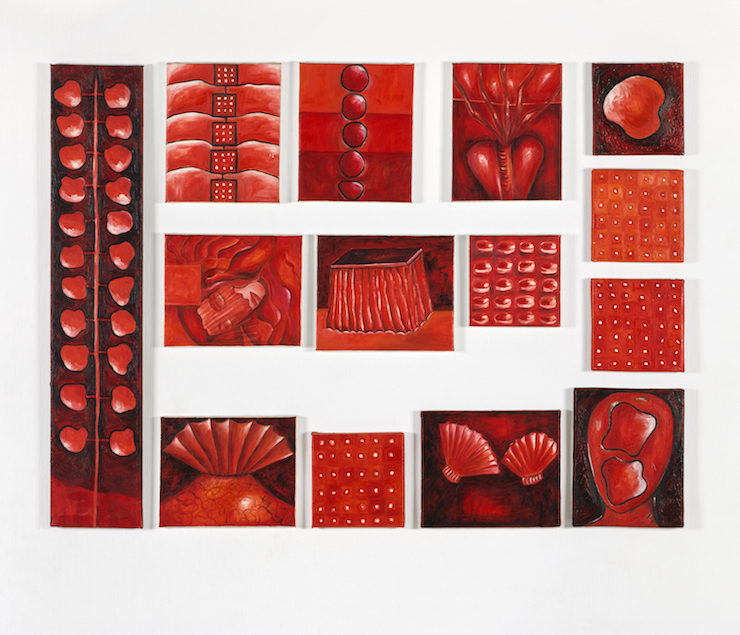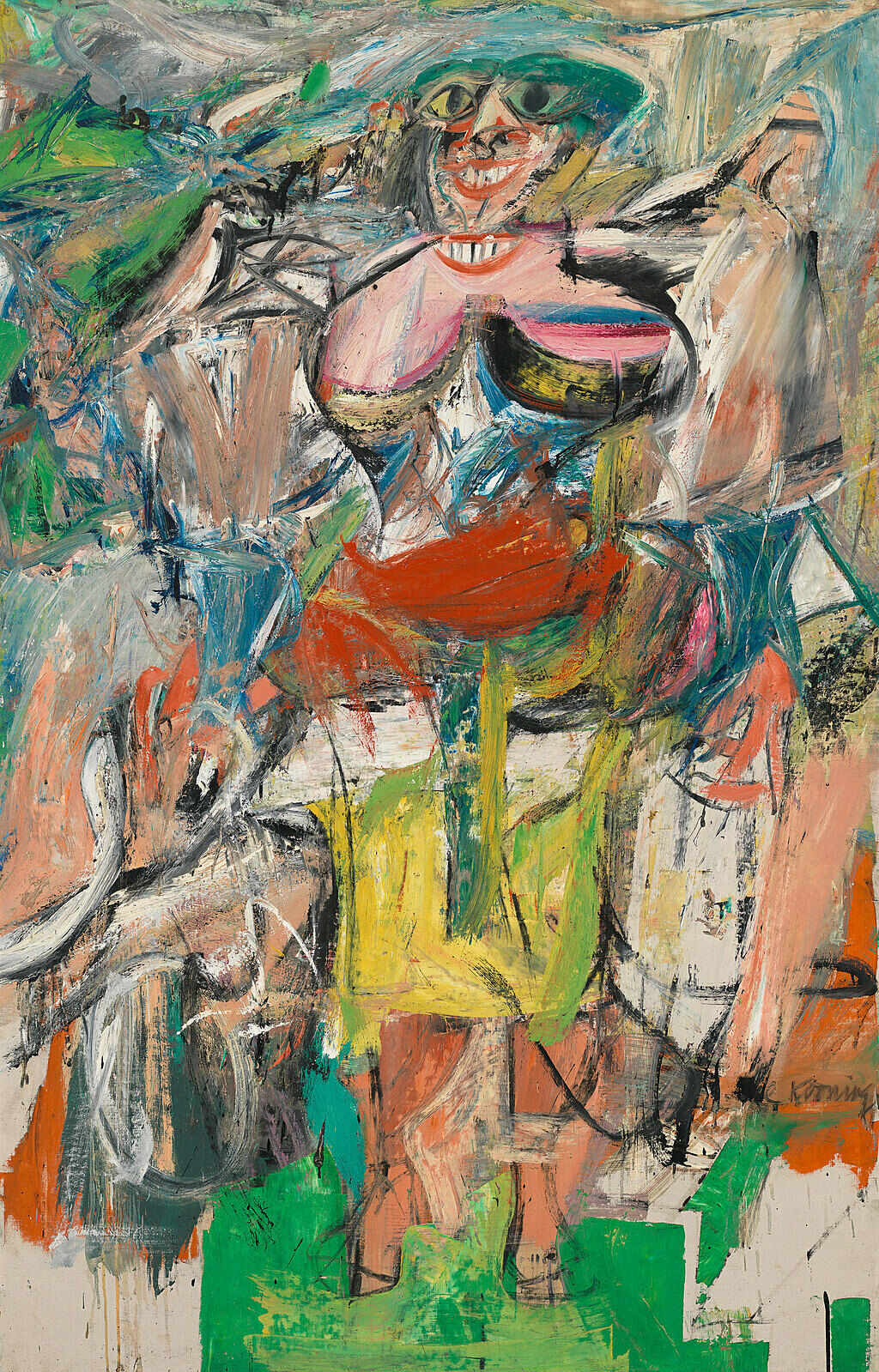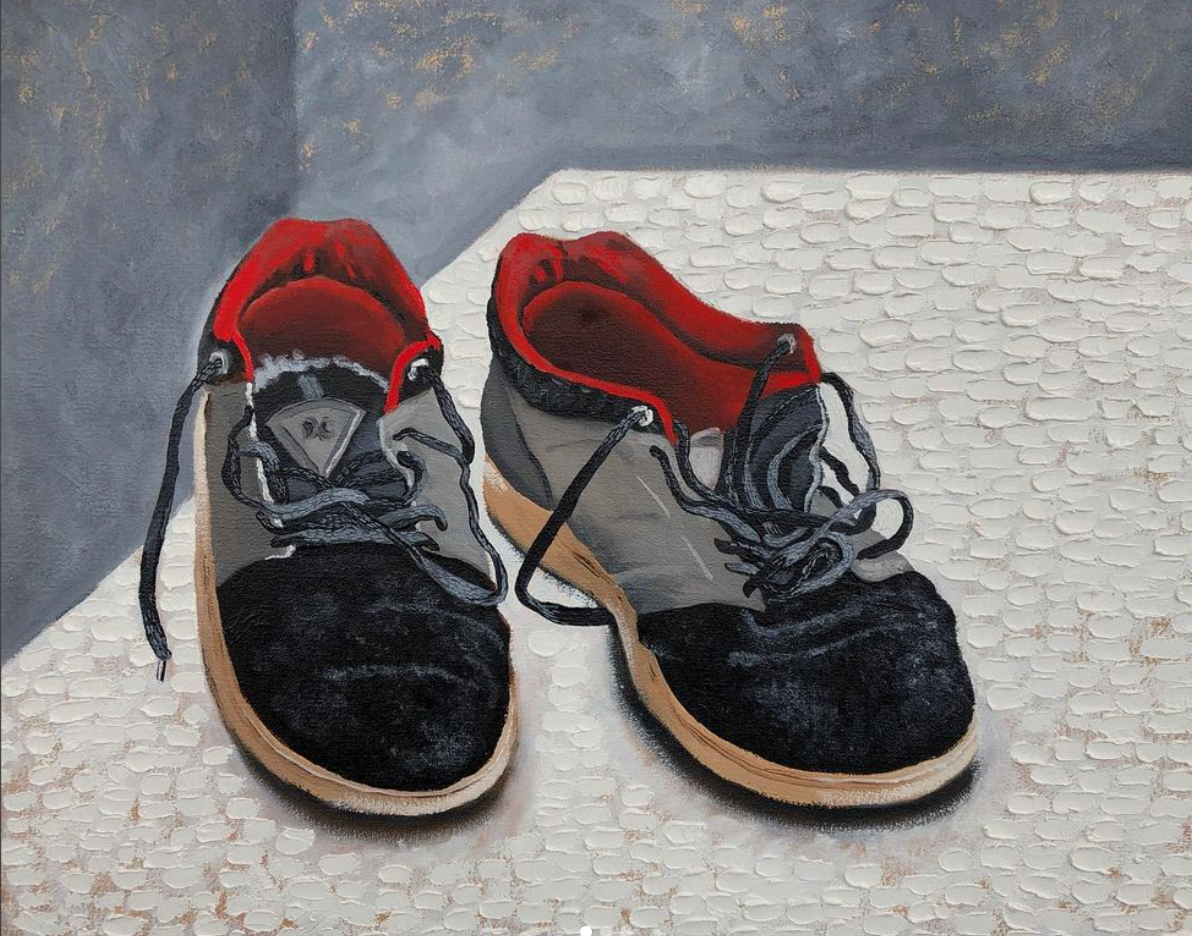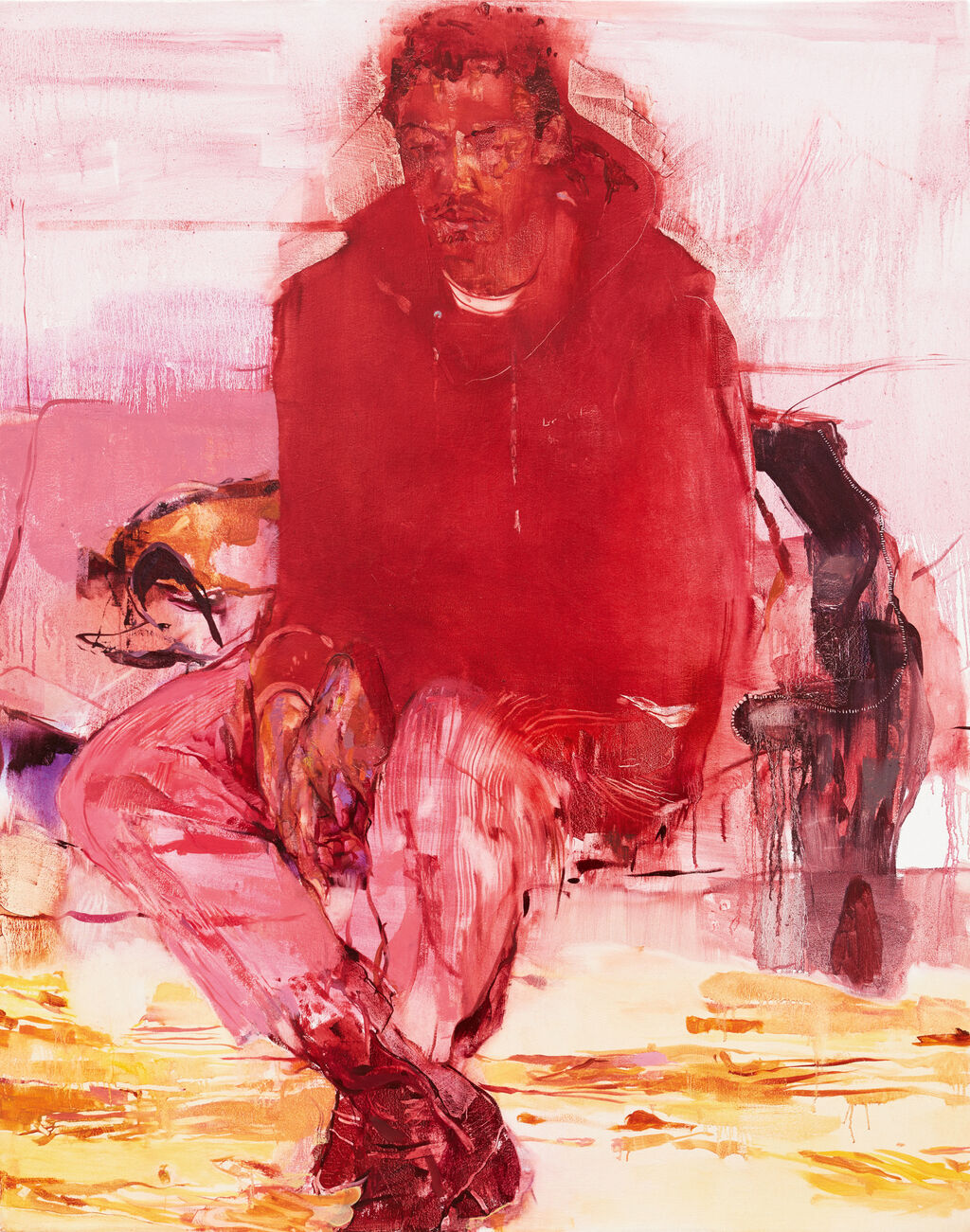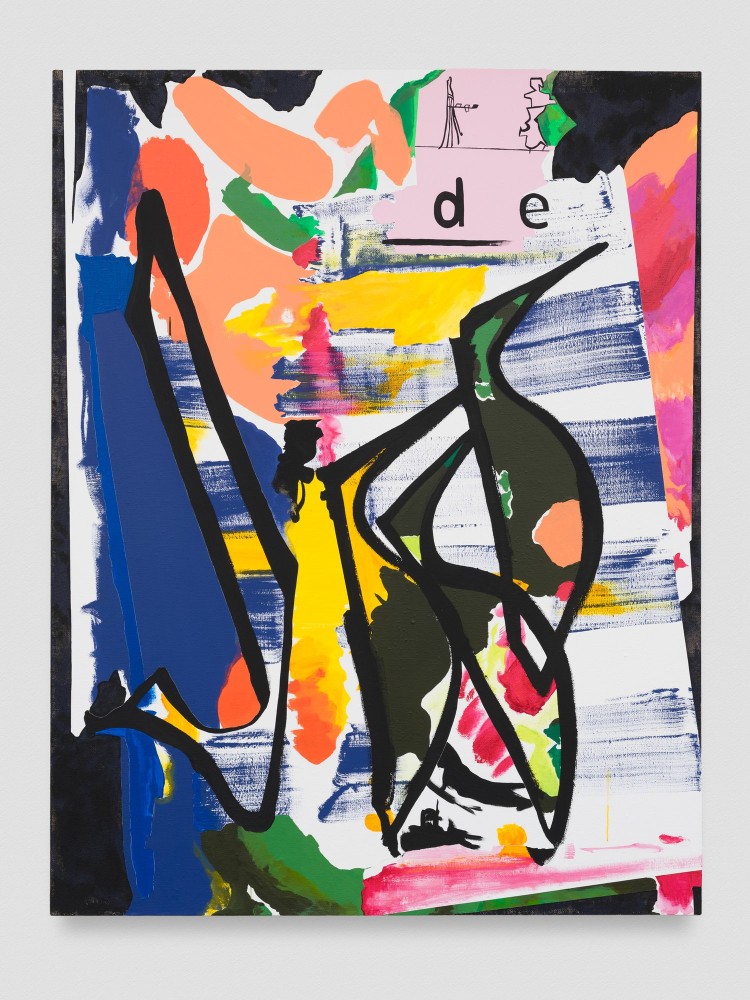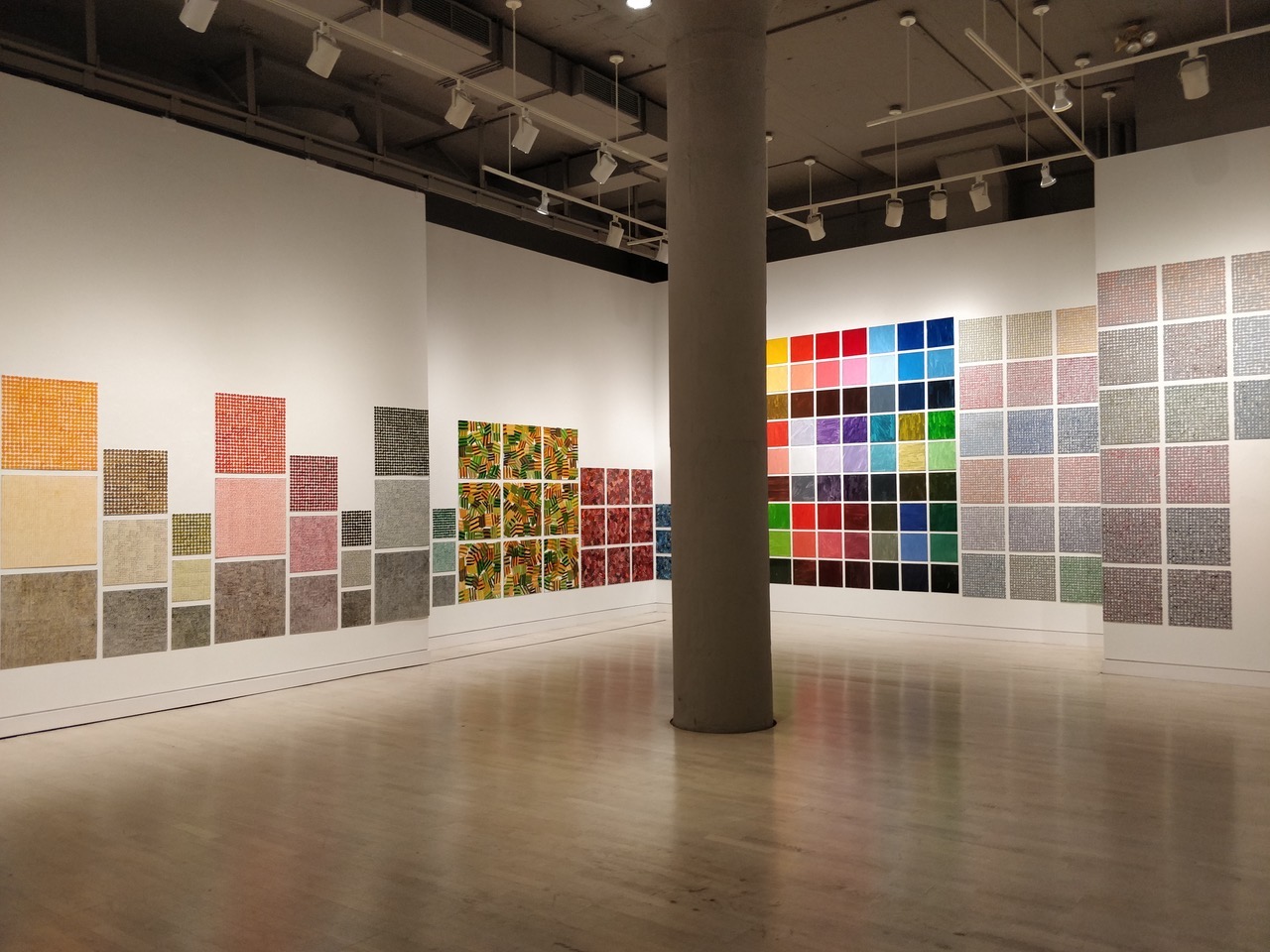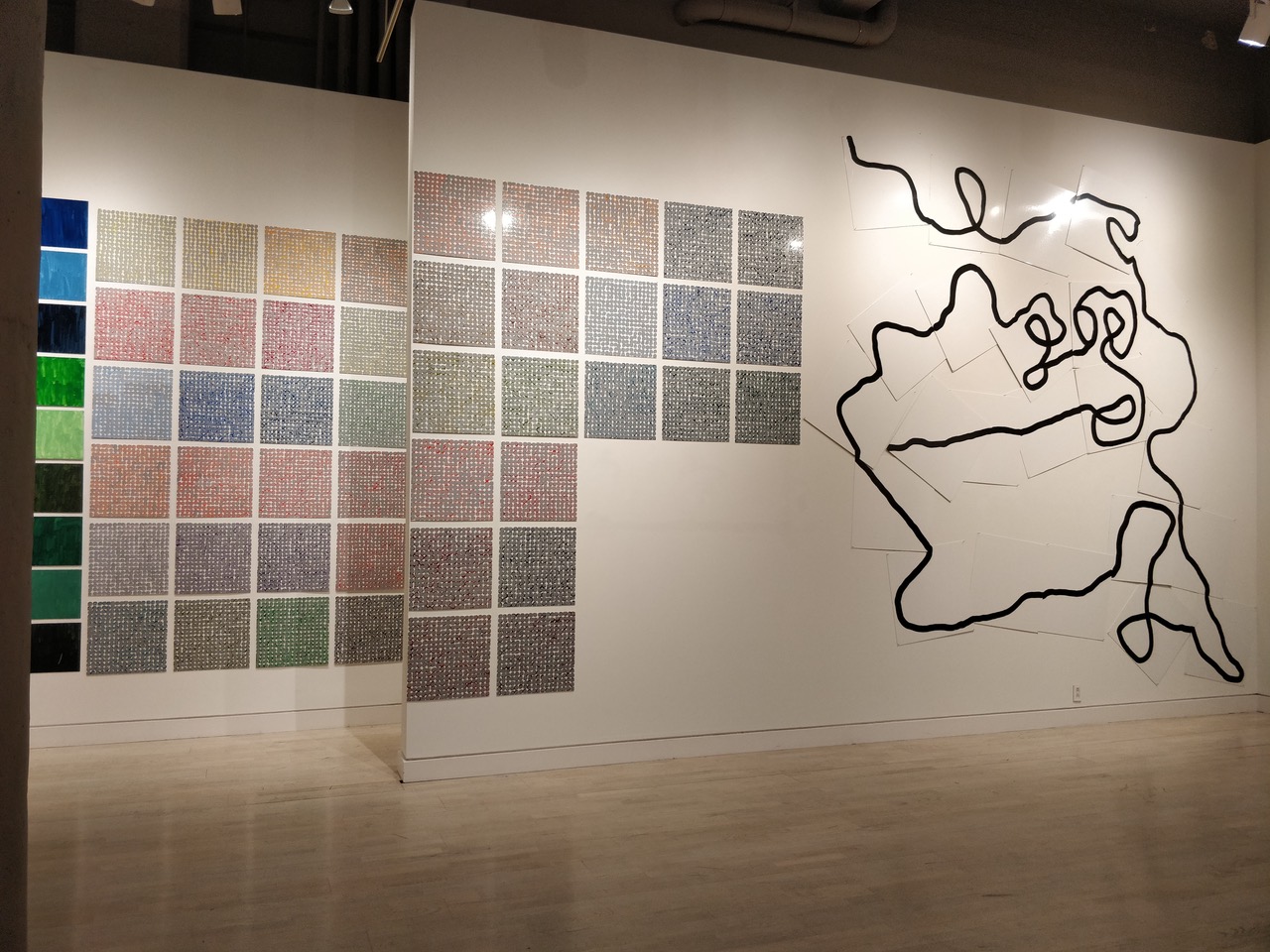Your cart is currently empty!
Tag: abstract painting
-

PICK OF THE WEEK: Silke Otto-Knapp
Regen ProjectsSilke Otto-Knapp’s paintings of cascading, roaming bodies feel as if they washed up on the shores of my mind like sedimentary particles— suspended and unsettled bits of matter that float and sink. Memories behave like mollusks, secreting trails of life, fading traces of the past. Clusters of silhouetted dancers appear to sprout from one another; their overlapping limbs form an intricate network tethered by some mysterious root.
Watercolor has figured into every aspect of the late artist’s practice and preparatory work. Repeatedly adding and removing paint on primed canvas, Otto-Knapp’s technical approach to painting might be described as a choreography of pigment, creating shadowy, cinereal worlds of grey. An installation of watercolor studies on paper are installed along a jagged horizon line that spans the length of the gallery wall, tacked loosely to the surface, causing them to flitter like leaves as I move across them, synchronously rippling like chimes as bodies move across the gallery.
Otto Knapp questions where the borders of life exist, imagining the strange and vast plains of life—abstract and figurative realms, psychological and physical. The silvery strangeness of Otto-Knapp’s greyscale worlds evokes the magical and longing feeling that sturs in me when I gaze upon the moon. Floating in the cosmos in one scene and swimming underwater in another, Otto-Knapp’s terrains are dark and light, thick and vaporous—figures move backward and forward, up and down, to the moon and back again. Her realms are vast, wide open plains where skies and horizons become fluid and unfixed.
Regen Projects
6750 Santa Monica Blv
Los Angeles, CA 90038
On view through August 12, 2023 -

PICK OF THE WEEK: Reggie Burrows Hodges
KARMAMemories appear shaky and cinderous, meteoric contusions of being and becoming, volcanic rumblings of the self, perpetually oozing and calcifying. Artist Reggie Burrows Hodges imagines psychic realms knotted and stretched by the spirals of space and time—warped and wobbly terrains of the mind, interior geologies made of craggy fissures and serrated shadows where perception and reality converge, perpetually entangled in reciprocal acts of transformation. Emerging in the layers of black paint that primes the surface of each canvas, figures appear as abstract dark luminescence, as traces of twilight emanating from fields of abounding depths, mysterious psychological realms of boundless complexity akin to something cosmic or oceanic. These dark pools do not register as hollow voids but tenebrous and vibrational currents—dynamic, intersecting layers of time and space where shadows dwell within shadows, bottomless dimensions endlessly scrambling and unscrambling.
To immerse oneself in memory requires ongoing construction and reconstruction, reckoning with fluctuating notions of self, fragmented histories, and present realities—attempting to make sense of the splintery intangible pieces of identity that may never be understood or feel whole. Hodges brings these tensions between the inner-psychic world and the outside world to the surface, dancing between figuration and abstraction to convey intimate scenes of self-reflection, sites where the psychic and spiritual are registered in lived realities and encountered in the familiar. Various reflective surfaces act as portals that seize upon moments of reflection and glimmers of self-awareness—portraits projected in a sleepy computer screen, in a compact mirror, illuminated in sliding glass doors, in the gentle lapping of water, rippling with fanciful visions of multiplicity, enticing one to dive in. Hodges depicts the experience of turning inward as a means to look also outward—a shift in perspective that illuminates the duality and friction between the interior, mental and emotional realms of existence and the exterior realities, an anxiousness rendered as a bubbling layer that pervaded Hodges work, swelling as our inner lives continue to rub up against the rigid outside forces of reality. This inside-out notion of the self and identity is inherently coded and elusive, pervading legibility as they are deeply situational, relational, and based on experience and worldview. The artist captures a spatial psyche that makes me want to tuck into myself—nestled in the innermost core of my being, where one is more sensitive and attuned to all that is not visible but profoundly felt, sensed and imagined.
Karma
7351 Santa Monica Blvd
Los Angeles, CA 90046
On view through July 7, 2023 -

PICK OF THE WEEK: Keegan Monaghan
Parker GalleryKeegan Monaghan’s paintings feel like the moldy nooks and crannies of a house or a well-worn shoe, rendered in epic and compact proportions. Their compositions shiver with an eerie affection akin to the apparitional creaking of my old, poorly insulated apartment. The passing of time is traced in the calcified goop that lines the maze of termite cavities in my floorboards, the layers upon layers of paint coagulating beneath the brim of molding, welling up like petrified tears.
At first glance, Monaghan’s paintings present as pure abstractions, intriguing compositions of indeterminate color and form. To fully grasp the nuances and peculiarity of Monaghan’s prickly, overworked surfaces and grotesque application of paint, requires my slow and intimate attention. A kaleidoscope of color permeates the painting’s stuccoey surfaces; the vibrancy and variation in each brushstroke are almost indistinguishable from afar—like grains of sand. Familiar shapes and shadows emerge as vague, fragmented impressions—images of woodgrain, a table’s edge, the frayed fringe of a rug—windows, screens, and shadows of all kinds evoke a domestic, architectural geology of the mundane. Monaghan messes with proportion and scale to evoke a sort of vertigo; an uncanny feeling inherent in the psychologically charged spaces we inhabit, making paintings that are architecturally and mathematically off-kilter, like retrograde studies on Renaissance perspectivism. While the paintings appear devoid of any human figure, there is an eerie underlying presence in their absence.
Parker Gallery
2441 Glendower Ave
Los Angeles, CA 90027
On view through June 10, 2023 -

PICK OF THE WEEK: Another World
Los Angeles County Museum of ArtCaptivated by the spiritual and vibrational aspects of the natural world, Agnes Pelton renders the invisible forces that surge through life. While Pelton is not the only artist included in LACMA’s survey exhibition “Another World,” she is the most compelling and dynamic artist in the Transcendental Painting Group. Interestingly, she was the least active member of the group, and her work was more figurative and less reliant on pure geometric form. Established in the American Southwest in 1938, the group’s manifesto states their aim “to carry painting beyond the appearance of the physical world, through new concepts of space, color, light, and design to imaginative realms that are idealistic and spiritual.” While most artists included in the exhibition adhere to these parameters, Pelton stands out for the ways in which she rendered biomorphic forms and landscapes. Strange entities—chains, whisps of smoke, whirls of light—dance and levitate among cumulous clouds, cosmic skies and inverted sunsets. Her paintings appear to be somewhat grounded in the natural world while simultaneously untethered from reality—an approach particularly evident in the painting Lost Music II (1950), inspired by Pelton’s view of the desert sky in Cathedral City. This work is abstract while also situated in place and experience, which, in some ways, diverges from transcendental ideals. This approach is expressed in the artist’s own words when she states, “the forms and activities expressed are no doubt related to experience, but only as distillations and seen on that plane that is neither past nor future–perhaps aspects of both–where shadow may become sound, and color enhanced to power, or light to radiation.” Pelton’s contribution to American modernism and abstraction seems to transcend any singular definition or categorization. Her paintings feel as relevant and alive as when she created them 90+ years ago.
Los Angeles County Museum of Art
Resnick Pavillion
5905 Wilshire Blvd
Los Angeles, CA 90036
On view through June 19, 2023 -

Layering Subjectivity
Q&A with Zoe WalshZoe Walsh is a Los Angeles–based painter originally from Washington D.C. They received their BA from Occidental College and Masters from Yale University. Represented by M+B Gallery, Walsh has exhibited their work in group shows around the world. In 2019, they were nominated for the prestigious Emerging Artist Grant from Rema Hort Mann Foundation and were the Al Held Foundation Affiliated Fellow at the American Academy in Rome in 2015. I asked Walsh the following questions to gain a better understanding of their artwork.
ARTILLERY: I know you studied under Linda Bessemer during your time at Occidental College. To me, there is a connection between how each of you experiments with paint. Can you comment on this?
ZOE WALSH: One link between Linda’s practice and my own is that we each construct paintings by stacking discrete layers of paint on top of and adjacent to prior layers, which is an approach that owes a lot to printmaking logic. The gestures of making are distributed through technologies ranging from squeegees to screens and spackle knives. Linda’s playful and rigorous exploration of the plasticity of acrylic paint is a continued source of inspiration.

Walsh in their studio, photo by Isabel Osgood-Roach In your early work, you incorporated images from Westerns and action films. Now you draw photos mainly from adult films. What contributed to this shift in subject matter?
A common thread from my very early work to my current work is my interest in using spectatorship to talk about dis/identification and desire. While pornographic images are interesting to me because they evoke complicated physical questions, I think the more intentional shift I’ve made is towards using material produced by and for queer people. As a result, I am more emotionally engaged with the complex set of issues that come up over the course of a long project.
A central theme of your work is queer subjectivity. When someone comes across your paintings, how do you hope they interact with them?
I hope that viewers spend time with and get close to my paintings and that each viewer brings their own subjectivity to their experience of my work. I believe that the dialogue that art can generate is transformative. Regarding queerness, it’s so rewarding if my paintings open up space for a viewer to recognize themself in the work.

Zoe Walsh, Knuckles on the equinox, 2021 , acrylic on canvas-wrapped panel , 48 x 48 inches I am immediately struck by the vibrant colors in your work. You use color in an obscure manner. Can you describe what thought or system goes into choosing colors for a piece?
One of the guiding color principles for my series of pool paintings is to work towards the quality of light that exists during the transitional hours between day and night. Those times when the contours of one’s body and the distances between yourself and another are more difficult to discern. A super-bright passage in a painting might not clarify, but dazzle and disorient.

Zoe Walsh, Lost Stars, 2020, acrylic on canvas-wrapped panel , 48 x 48 inches How does technology play a role in your practice?
I use digital technology such as Blender, Photoshop and Illustrator to develop compositions and then employ screen printing to print the first layers of each painting. My process entails shuttling back and forth between the analog and the digital as I develop each piece with additive layers of stencilled acrylic glazes. The paintings that emerge from this exchange reveal a hybrid form.
-

GALLERY ROUNDS: Loft at Liz’s
Group Exhibition “Diverted Destruction 15: The Demolition Edition”Co-curated by Liz Gordon (of Loft at Liz’s) and Monique Birault, the 15th iteration of Gordon’s ecologically driven “Diverted Destruction” is both exciting, and more visually spare than past exhibitions. Rather than filling the main gallery space with smaller pieces created from recycled materials, this time around the artists confront waste created from construction and demolition materials.
Using concrete, asphalt, wood, drywall, brick, clay tiles, shingles, and metal, artists including Anna Stump, Sonja Schenk, Ben Novak, Joseph Salerno and Howard Lowenthal work in a variety of approaches to this material, while in the gallery’s alcove, a robust and ever-changing collection of materials are available for giveaways, with mixed media workshops encouraging their use.
Schenk’s piece is a suspended, monumental work evoking memories of the 2001: A Space Odyssey monolith had it cracked into pieces and turned horizontally with her Solid, Void, Other (Red Shift) made from polystyrene, glass, and acrylic paint to float like a feather of detritus.

Anna Stump detail Stump’s approach is playful: her Mojaveland Jackrabbit Hole recreates a Par 3 hole from her artist-designed miniature golf course and art center in 29 Palms. Made of broken concrete bricks originally used to build 1950s-era desert homes, the mobile mini-golf puts these found commodities to cleverly visualized delightful use. Also on exhibit: a series of mix-and-match painted concrete bricks, some delightfully depicting exquisite jackrabbits.
Novak works in welded metal and plastic found objects, creating what he terms “environmental work” dedicated to sustainability. He uses vintage tools in a numbered Weisman Tool Series, and found metal objects to create fascinating, elaborate mini towers in his Pandemic Year 2 Series.

Howard Lowenthal detail Lowenthal, a.k.a. SMTDLR, shapes irreverently fantastical mixed media in his Terra Inifrma, crafted from aerosol, acrylic, and sculptural debris. Salerno’s work feels more substantial, using industrial materials with minimal touches of color, such as oriental pink marble in his Shelter the Weak, and a softly glowing beige travertine along with rebar and stone for his in a landscape. While the materials are primarily industrial, these works seem to inhabit an imagined natural geology, like new sedimentary rock formations.
The exhibition is on display through September 20th at Loft at Liz’s on La Brea, mid-city.
-

RICHMOND, VA: Diego Sanchez
VISUAL INFORMATION“One of the things I teach my kids is to be playful in their approach,” says painter and teacher Diego Sanchez. This freedom to experiment takes the pressure off and opens up the work in unexpected directions. It’s an attitude that has served Sanchez well in his own practice.
Sanchez lives and works around Richmond, Virginia, a city with a vibrant art scene. His story is not just about becoming a successful artist, it’s also an inspiring account of an immigrant starting with nothing and rising up through the ranks of his profession. Born in Bogotá, Colombia, Sanchez came to the US in 1980 at the age of 15. His father, a judge, had refused to cave to pressure from drug cartels. Fleeing for their lives, the family ended up in Northern Virginia. Sanchez, who had opted to study French at school in Colombia, spoke no English. It was an art class that changed everything, providing a means of communication. “I realized with art, you didn’t need English or French, anyone could get it,” he says.

Composition #6, 9×12 inches, mixed media on paper, 2021 After graduating from high school, with no money for college, Sanchez enlisted in the army. On completion of his military service and college degree, he attended Virginia Commonwealth University School of Arts, one of the best art schools in the country, where he received his MFA.
In the years following, Sanchez cobbled together a career with teaching gigs at various places around Richmond. His first full-time position was at Virginia Union University (one of the oldest historically Black institutions in Virginia), where he taught for five years. Eventually, he was offered a position at St. Catherine’s School (a distinguished private girls’ school), where he has been teaching for over 20 years. During the summer, he leads art classes at the Virginia Museum of Fine Arts (VFMA) and at Richmond’s Visual Art Center.

current work in progress, 48×36 inches, mixed media on panel, 2022 One of the first things you notice about Sanchez’ work is the surfaces. He uses a water base to develop them, coming back with layers of oil and cold wax. He also uses unorthodox materials—coffee to stain and soap mixed with pigment to create bubbles of paint that burst and leave behind nebulous rings of color. He likes playing with visual information. Sometimes he starts by creating realistic space and then paints something flat on it or adds patterns or text. “To me, a painting is a record of whatever is happening at the time. For instance, sometimes when I’m working in my studio, my wife will say, “Hey, can you pick up some milk?” So, I’ll jot down, pick up milk, on the work. I may cover it up later, but little glimpses of my life remain, becoming part of the painting.”
To center and relax during the stressful months of the pandemic, Sanchez started putting lines on paper. “I used this wonderful walnut ink. I love the earthy color, the opacity, the way it handles. I first created a simple structure of lines and then came back with the grid. I did a whole bunch of them, combining some with cold wax. It was like making a structure out of chaos.”

Composition #124, 32×40 inches, mixed media on panel, 2021 His work was changing, and with an upcoming show on the horizon, he set himself the challenge of doing 100 small pieces on paper. These gave him ideas on how to move forward, shifting from the handsome arrangements of geometric shapes to looser compositions that incorporate amorphous forms and interesting color pairings. In these works, texture and pattern possess an enhanced earthiness that imparts soul.
According to Dr. Michael R. Taylor, chief curator and deputy director for art and education of the VMFA, “Diego Sanchez is one of the most exciting and respected artists working in Richmond today, the museum loves his work, and we were proud to acquire Composition #76 for the collection in 2018.” Certainly, the measure of success is the acquisition of your work by a major museum, but Sanchez, like many famous artists before him, has the added coup of having his own merch available in the museum shop, which carries a puzzle and socks based on the acquired painting. Not bad for a kid who, at 15, had to start all over again from square one.
-

PICK OF THE WEEK: Victoria Gitman
François GhebalyA series of precious objects rendered in oil paint requires your intimate proximity. Tiny tactile paintings of levitating furs, beaded coin purses, costume jewelry and sequin fabrics depict trompe-l’oeil images of feminine objects commonly associated with glam, flamboyance, and the body. Gazing at these luscious surfaces, your eyes cannot help but indulge in the pleasure of looking, noticing the kink of every hair and the flicker of each bead.
Victoria Gitman’s exhibition “Everything is Surface” at François Ghebaly presents a survey of the Argentinian artist’s twenty-year career. Gitman’s paintings are fetishistic artifacts; the sensual and vibrational quality of each painting is achieved over the course of several months. Sourcing materials from flea markets and online shops, Gitman selects objects based on how they resonate with her personally–a collective trace of the artist’s own subjectivity. In her essay “Notes on Camp,” Susan Sontag describes the essence of camp as “esoteric–something of a private code, a badge of identity even.” The alluring and allusive quality of Gitman’s work inspires a playful desire.
Another series of paintings titled “A Beauty” features women rendered by male artists in art history, punctuating the walls as you enter and move into the second gallery. Here, Gitman offers critical art historical commentary on gendered gaze and feminine perspectives in painting (or the lack thereof). Gitman’s feminine “camp sensibility” undermines macho-modernist ideologies. The artist reminds us that feminine pleasure is a form of freedom and joy.
François Ghebaly
2245 E Washington Blvd
Los Angeles, CA 90021
On view through May 7, 2022 -

GALLERY ROUNDS: Jonas Wood
David Kordansky GalleryJonas Wood’s highly patterned and flattened paintings take up all four gallery rooms at David Kordansky Gallery. Evoking the decorative arts, their inherently “attractive” quality reminds one of a painted mosaic. Wood created this affect by using deliberate linear brushstrokes atop flattened fields of opaque colors, to create a highly ornamented painted surface. The result is work that feels more along the lines of tapestry than paintings. Although the paintings are playful in character, the stylization and methodical application remove any semblance of expressivity from the paintings, leaving no room for error and nothing at stake.
As the name of the show suggests, the content of the paintings largely focuses on “Plants and Animals” inhabiting the domestic living spaces of the bourgeoisie. The point-of-view of the paintings are from inside or outside affluent architecture. The general feeling is too comfortable and well-situated to feel voyeuristic—and ends up suggesting the social status of Wood himself. Unlike the Post-Impressionist genre that the paintings are referring to through his compositions (homage to printmaking and flattened patterned brushwork à la Gaugin or Matisse), Wood’s paintings do not feel like they are painted for fellow painters, but rather for his established collectors.

Jonas Wood, Deer and Picasso, 2019, oil and acrylic on canvas Allusions to high living and designer tastes are frequently dispersed within the pictures. Privileged pastimes are hinted at, for example the painting Deer and Picasso from 2019, feature a Picasso painting on the wall, a pet deer lounging on a wicker sofa and a SURFER magazine atop a coffee table in the foreground. In the painting Patterned Interior with Mar Vista View (2020) the painted plants are ripe, alive and full with saturated colors. The mirthful pattern of the drapery and sofa create a visual kinetic energy that buzzes above the picture plane. This painting—like many others in the show—use an opened window motif; the paintings themselves are like open windows into a fabricated LA paradise, accessible only to the happy wealthy people that will in-turn own these happy expensive paintings.
Jonas Wood: Plants and Animals
January 22 – March 5, 2022
-

OUTSIDE LA: Gosha Levochkin
The Hole, New YorkKicking off 2022, New York’s The Hole has debuted a solo show from Gosha Levochkin, the gallery’s first with the Russian American artist. Wild, vibrant and interminably buzzing, Last Element is rife with bright constructivist shapes, cartoonish figures and references to graffiti, comic books and Japanese animation. Levochkin’s paintings are far from narrative, yet the shapes and figures come together in dreamy scenes that invite the viewer on a trippy, electrified journey.
Welcoming the viewer are two aptly titled paintings, Up and Down (2021), that depict jumbled figures blending into and climbing on top of one another. Their brightly colored noodle arms pull thin ropes in apparently endless motion. In Up, the figures appear to be on a ladder, perhaps on a playground. Down imparts a similar feeling of play with a paper boat floating calmly in light blue water. However, despite this element of play, there is something slightly sinister about the overlapping bodies. Are they forever stuck in motion, climbing, tumbling and pulling like Sisyphus? Is the rope being dipped into the water in Down really a rope, or is it an electrical wire? This subtle tension and hint at discomfort continues throughout the show, lending every work an air of excitement, as if the scenes unfolding are about to burst into motion.

Gosha Levochkin, Down, 2021 The people in these first two paintings seem to be on a wild journey. As the show continues, they jump into environments with unidentifiable shapes and architectural elements that melt into one another. In Hybrid Power (2021), a cart carries purple-haired figures. A cord plugged into the wall is attached to a device that emits frenetic, jagged bursts of energy bouncing in various directions. Architectural features like columns are sucked into the central jumble from some unknown source. Perhaps this is another image of a figure at play, or perhaps they are hard at work with their arms frantically completing a task.

Gosha Levochkin, Found Nothing Splash, 2021 A similarly buzzing scene unfolds in Found Nothing Splash (2021), in which space and logic are fully abandoned. A large figure stands on the right and looks out onto the swirling tornado of colors and jagged lines. Additional figures appear in fragmented, confused postures, as if being sucked through the swirl. Tiny people jump around the whole composition, springing from place to place.

Installation view of Last Element, 2021 Contributing to this sense of movement and play is an audiovisual animation installed directly into the gallery wall that Levochkin made with motion graphic artist Jonny Lee. Like stepping into the virtual realm of a video game, the work features an animation of water cascading out of a large red pipe and into a bright blue current. The constant flow points to the interconnectivity of humanity, a fact that has become increasingly true with our reliance on all things digital over the last two years. Adding to the virtual feel is the audio score created by Jay Rothman, a composer and sound designer with a background in early video game music.
Whether at work or at play, the figures that weave in and out of Levochkin’s energized scenes are hard not to love. With bright colors, wild scenes and jagged lines bursting with energy, Last Element is refreshing, exciting and a welcome invitation to embrace the chaos.
Last Element is on view through February 27th, 2022 at The Hole NYC, 312 Bowery, New York 10012
-

GALLERY ROUNDS: Ilana Savdie
Kohn GalleryIlana Savdie’s first solo show with Kohn Gallery comprises 13 canvases and nine works on paper. Savdie uses vivid color, structure and composition to explore ideas of a liquid world as a metaphor to an ever-changing identity.
The title of the exhibit “Entrañadas” translates as “innards” in English. It is the interior or what is within that is the focus of this new body of work. As a queer artist, Savdie is interested in the idea of shapeshifting as a means to explore her identity. This is where the idea and concept of “fluidity” or liquid, come into play. Throughout the new series, the composition is chaotic with acidic bright neon colors and shapes that morph into body parts and figures as they intertwine with one another, establishing and collapsing shapes within each canvas.

Ilana Savdie, Falsos Positivos, 2021 In the painting Queen Breeders (2021), Savdie portrays two hooded faceless figures with other recognizable objects appearing, including the Marimonda mask—a folkloric symbol from the artist’s native Colombia—employed to mock the oppressive elite. The painting is a statement between the migratory nature of Savdie’s life and the flexibility of her identity. In Falso Positivos (2021), talons and police body armor make their appearance as part of a contemplation of the current sociopolitical condition. The liquid world of identity and gender dominate the paintings of Savdie. Not “fitting in” to a certain ideal is to become shapeless, thus the melding forms in the painting.
The opposing natures of the solid and fluid are pivotal in understanding Savdie’s work. In the mid-20th century, Surrealists such as Dali, Ernst and Tanguy used the biomorph to explore the unconscious and dreams. Savdie’s painting uses it as a means to investigate queer identity, migration and the current zeitgeist. In Ilana Savdie’s “Entrañadas” the works flows to an assertion of being real—both inside and out.
Ilana Savdie: Entrañadas
November 6 – January 29, 2022
-

The Spiritualized Landscapes of Hung Viet Nguyen
DEVOTED TO NATURE“Art is a universal language,” Hung Viet Nguyen says. “And when I came here as an immigrant, my English language was not that great. My strength was in painting. I slowly convinced people that my art is my language.”
Nguyen came to the US from Vietnam in 1982, with a background in biology and a lifelong passion for art. After making the move, he decided to make art his livelihood as well. A course in technical drawing led to a career as an illustrator and graphic artist while raising his children and pursuing his fine art. For seven years he stopped painting to experience nature both in solitude and with his family. “I absorbed the texture and the culture that nature taught me,” he says.
Pattern, color and subject all inform Nguyen’s narrative, spiritual art, the elements of which arise entirely from the artist’s personal experience and interpretation. “Artists balance what happens to them in life with their art,” he says. “When things were all good, sunshine—normal in California—my work was darker for a while, but when the pandemic hit, and it looked so bad, spirits were so down, I made my colors brighter. I wasn’t trying to escape but to balance what my art said with what was happening in the world.”

Nguyen in his studio, photo by Genie Davis; Regardless of the palette Nguyen uses, his work is always spiritual, and devoted to nature, as he himself has been since he was a child. “That is always in my mind from a young age. I had respect for trees, rocks, plants. It’s not religious, it’s spiritual in respect to everything surrounding me—after all, they’ve all been there longer than me.”
Nguyen is currently creating his fifth series of “Sacred Landscapes,” a body of work which average approximately 50 paintings per series. He viewed the cycle of nature through four previous series, titled “Cruelly Go Round;” “Coastal Sensibilities,” which focused on the sea; “Myscape,” referring to his personal landscape; and a more abstract series, “Symphony.”
“What led me to ‘Sacred Landscapes,’ was that we live in a city. I need to live here to work, to sell. But nature is a counterbalance. When I need to, I go to the beach or the trail. I call it going to the temple. Nature to me is closer to God than [I am] in a church.” He often travels the country and abroad to experience nature, with two areas in California most special to him, the Ancient Bristlecone Pine Forest near Bishop, and the Palos Verdes Peninsula near LA.

From series, “Sacred Landscape V,” #27, 11” x 14″. Inspired in part by Asian scroll paintings, highly textured, intricately detailed and visually immersive, Nguyen’s work is created by both palette knife and brush. He runs through so many palette knives that he has collected the used ones on a long chain that hangs from the ceiling of his studio. “I wear out the stainless-steel painting on canvas, that’s how much I use them. But I also use the brush when I want to create something more fluid.” He explains further, “For me the texture comes first, it’s part of my pattern. It can create anything, like a mosaic. When I am out in nature, I look, and I think, I can match that surface, I can recreate that. I think when you have a language, you have an alphabet. And with that alphabet, you can make anything, say anything, good or bad. When I am lucky, I can use my language well, and things like texture turn out as they should, smooth, or soft, or hard.”
Nguyen also sometimes incorporates actual words in his work. On his large-scale (48 x 84 inches) Sacred Landscape V, #32, his wife’s name and mother’s name are partially revealed within the grassy areas of the vast painting. “My wife understands me and lets me have the freedom to create. I also wrote in this piece ‘into nature, open out senses, feeling/seeing, gentle and dangerous magnificent, ask no more, common, extraordinary.’” The work itself is all that. To the left, a clear lake surrounded by a meadow, behind which a glacier rises, slipping into the sea; a steep, vertical volcano with hot lava still seething inside takes up the middle section; another volcano appears to have finished its act of tumultuous creation and adjoins a blissful series of waterfalls, ocean, and another lake around which two small human figures are poised under a rich burnt-orange sky. Both dream and fable, fairy tale and Adam and Eve–Biblical, this work is not just an alphabet of language but an entire novel.

From series, “Sacred Landscape V,” #36, 84” x 48″. While Nguyen doesn’t specifically see his Vietnamese heritage in his work, he realizes that “my painting looks different than Western painting in some ways,” in that he doesn’t work with perspective. “I create space that isn’t restricting. You can look down or up, as you do when you are in nature.”
Oil on panel, his large vertical work Sacred Landscapes V, #36 features a cavernous volcano, visually twinned with a cascading waterfall spilling into the sea; some smaller panel pieces such as Sacred Landscapes V, #27 feature glacial forms and sea, with the glacier cracking into the ocean; Sacred Landscapes V, #30 is a beautiful, sinuous tree. From an earlier series, Sacred Landscapes IV, #40, gives viewers a dark and transcendent night sky, with a mystical circle suspended above grey hills. In the foreground, a small figure and his horse cross this mysterious landscape.
His subjects in nature are limitless. “Nature taught me my style, which comes from a pattern,” he says. “I am just creating the language; it is a journey of discovery. I think I am going to keep painting for a very long time. I haven’t seen anything that limits me, yet. Sometimes a new element comes up, right now that has been volcanos.”

From series, “Sacred Landscape IV,” #40, 12” x 12″. On days that his studio is too hot or cold, the artist has begun doing smaller pieces in his home, using old product tins such as small metal cigar boxes. He uses both inside panels to create two separate small works that are linked together. In one such piece, Stars Grazing, a couple lie on the grass, looking up on one side. On the opposite side, a filament of stars is strung. To create these he uses pencil, ink, watercolor and varnish. “I use different kinds of varnish—some look old, with a lot of crackle in them. That is something I’m experimenting with.”
Nguyen is prolific and sells approximately 50% of his work. “When you sell, it stimulates you to work harder. Picasso once said he was a good collector of his own work,” he laughs. “It isn’t about selling for me though. I can’t control that. If I work honestly, I satisfy myself, and I believe that if you do honest work, the work will find a way to get out there. If my work is good but no one sees it, they don’t know it is there.”
See Nguyen’s work in March 2022, at the Kleefeld Contemporary Art Museum at California State University Long Beach.
-

CODAworx Takes Over the Desert
Extreme Public ArtCODAsummit 2021 was marked by an in-person conference in Scottsdale, AZ which coincided with the dramatic light/art/water event titled Canal Convergence. While there was a COVID-friendly digital component for those not in attendance, the turnout was relatively staggering—a volume of renowned artists, museum directors and some of the heaviest global art fabrication companies all making the trek to the Arizona desert.
For those not familiar with CODAworx—simply put, it is an organization with a purpose of bringing together the needed elements to create public art on a massive scale. CODAworx touts itselves as “the hub of the commissioned art economy.” It is a singular place where those commissioning art can link to creatives, fabricators, engineers and most any others needed to actualize a project. A thrilling announcement at the conference was that CODAworx is nearing the $2 billion mark for commissioned public works; Yes, billion with a B.
The conference wasted no time diving into controversial issues around both COVID and problems with the traditional art institution model. Christy MacLear (inaugural CEO of SUPERBLUE, Rauschenberg Foundation, etc.) moderated a panel with artist and museum professionals that addressed The Reimagined Museum. The theme that continued to surface during this panel was how COVID regulations forced the archaic museum model to finally adapt, with new ideas, contemporary programming systems and nontraditional methods for engaging the public. Jeremy Strick (Director, Nasher Sculpture Center) spoke about the series of the “Nasher Windows” exhibitions that were presented to remain relevant during a time of nonpublic gathering. It’s worth noting that nearly all changes made in programing during COVID were highly successful and will be remaining in some context moving forward.
CODAworx organized presenters in a grounding dualistic approach, with conceptual art conversations were followed by tangible presentations such as the talk by Daniel Tobin, co-founder of fabrication powerhouse UAP. Daniel addressed the current need for manufacturing on a global scale—UAP has a facility in Australia, China and New York—but also the menagerie of difficulties that come from manufacturing public art on that scale.

The Reimagined Museum panel. Photo credit: M.O.D Media Productions The final component of CODAworx is the actual creative, the artist. Plenty of interesting presentations focused on the use of solar panels, robots or some tech in the artwork, but the standout artist was one with a far more traditional process. Los Angeles painter Ryan Sarfati, aka Yanoe, found his artistic footing while straddling large-format mural production with an AR twist. Yanoe takes both his moniker and learned skillsets from a prolific youth of graffiti painting in LA. He now applies them to world record setting murals as a part of a two-artist team—Oh Yanoe, LLC. The Majestic is a 15,000 square-foot mural in Tulsa, OK, which was finished in 2021 and is officially the world’s largest AR mural. This is not the first time Oh Yanoe has held the record, just the most recent. Their murals integrate community focused imagery and are inherently bright, stunning and dramatic to the naked eye. If the viewer chooses to employ the AR component it all starts to get real. Portions of the mural morph, hummingbirds fly off the wall, flowers grow and engulf the building. This is something new, and something great that builds on traditions we embrace.
Art and technology have been integrally related throughout the trajectory of human history with our current day and age being no exceptions. CODAsummit 2021 exemplified how many of our world’s foremost creatives are pushing the boundaries, working on global issues, and adding beauty into this world through the integration and use of technology in public art.
-

Remarks on Color: Recalcitrant Red
January’s HueRecalcitrant Red has gone on strike once and for all, having shirked his usual duties which include the setting of campfires, blood drives, Naugahyde sex parties, riots and any activity where the devil is set to make an appearance. Recalcitrant Red has turned his back on the industry of violence, even going so far as to boycott action films where his presence is the most necessary ingredient in a culture hell bent on destruction.
Now when you go to see Keanu Reeves’ latest foray into head splitting, blistering revenge, the requisite river of blood does not flow. Instead, the studios have had to make due with Burnt Orange, which is more reminiscent of Thanksgiving supper than John Wick! Recalcitrant Red’s refusal to participate has not only affected the film industry, but also greeting card businesses across the greater United States where young men can no longer descend on bended knee, extending red roses, to beg their lover’s hand in marriage. Somehow Peonies just don’t cut it! The tried and true red and green Christmas sweater has also suffered, as pink, a last-minute substitute on mittens and sweaters can be seen all across America as Recalcitrant Red continues to test the limits of his absence like a libertine come home from the war
Recalcitrant Red once famously exclaimed “You can’t give the finger to the blind,” and with that comment was banned irrevocably from The National Federation of the Sightless for all eternity. Recalcitrant had to draw the line somewhere and did make the occasional appearance at several high-end fashion shows in and around Milan, where he could be seen showboating on a pair of gleaming vinyl chaps, replete with two perfectly formed half-moon butt cheeks. Of course, other colors fiercely criticized his complete lack of personal responsibility not to mention his abysmal taste, but rarely does Recalcitrant Red take stock, flanked by his constant cohort, the Devil, and opting instead for the most garish, high profile exit he can muster.
Richard Prince, Graduate Nurse, 2002 Titian, Madonna and Child with Saints Catherine of Alexandria and Dominic, and a Donor, 1513 David Lynch, still from “Twin Peaks,” 1990 Larry Bell, Bill and Coo, 2019 Alexandra Noel, Devil Dog I, 2016 Jasper Johns, Target with Four Faces, 1955 Barbara Kruger, Untitled (Questions), 1990 Cindy Sherman, Untitled #567, 2016 Jutta Koether, First Class Road, 1986 María Fragoso, No me comas, 2019 Willem de Kooning, Woman and Bicycle, 1952 Cole Case, Last Shoes, 2021 Jennifer Packer, The Body Has Memory, 2018 -

Pick of the Week: Lindsay August-Salazar
Lowell Ryan ProjectsFew grasp the power of language to be visually enthralling while expanding our consciousnesses as well as Lindsay August-Salazar, whose solo show at Lowell Ryan Projects, “There’s No Place Like No Place” brings these questions to the forefront. Employing vibrant color schemes punctuated by a symbolic lexicon of the artist’s own invention, August-Salazar challenges us to recall a poetic past and make our own meaning in the face of our ever-changing mediascape.
The exhibition opens with six large-scale, burlap-grounded paintings that showcase August-Salazar’s fearless command of color and energetic brushwork. In her animated compositions that appear to levitate off the canvas, every rhythmic swath, gesture, and shape are as cohesive and captivating as recorded choreography — vestiges of her background as a hip-hop dancer.
The paintings also feel distinctly collage-like in their amalgamation of symbols and use of cutouts that tease fragments of coarse burlap beneath the glib acrylic. In referencing collage, August-Salazar reiterates the sheer multitude of histories, meanings, and interpretations that characterize her exploration.
Up in the sun-soaked loft, August-Salazar displays a suite of 47 unframed works on paper that echo the vibrancy and linguistic themes of her paintings, furthering them through repetition. I felt like I was entering a secret playroom or ancillary studio space brimming with insights to her creative process or possibly long-awaited clues for translation. Hanging gracefully off the wall, these delicate works introduce an element of levity and evoke a sense of childish whimsy and wonder to complement the palpable intensity of the paintings below.
At every turn, certain symbols of August-Salazar’s visual vocabulary (which she fittingly titles Abstract Character Copy) jump out — a smattering of English letters, a trio of hieroglyphics, a half-crown, an arc of yellow reminiscent of a Warhol banana. Each individual element of her wide array of visual signs felt vaguely familiar yet entirely unprecedented, like faces I’d seen in a dream that I yearned to recognize.
Through the eccentricity and indefinability of her visual vocabulary, August-Salazar conceals more than she reveals and offers little more than a sparing understanding of a hidden message only she knows. She thereby creates the uncanny feeling of walking through her own personal utopia — one that I was overjoyed to have been invited into even though I didn’t speak the language.
Lowell Ryan Projects
4619 W. Washington Blvd
Los Angeles, CA 90016
Thru Dec. 11th, 2021 -

OUTSIDE LA: Jennifer Bartlett
Locks Gallery, Philadelphia, PAVarious sizes of square panels mostly covered with dots with groups of parallel lines and occasional fields of paint line the gallery walls of Locks Gallery in Jennifer Bartlett’s installation “Recitative”—its title derived from a rhythmic free form vocal style of 16th-century Florence.Vertical groups of threes begin the left-to-right read and as the gaze traverses the arrangement, resonances build. The characteristic viscosity of enamel paint allows for different thicknesses and therefore different hues of blues, reds, yellows, greens—even as the palette expands. There is a rhythmic build as the eye tracks back and forth throughout the pattern overall, with single panels that emerge causing a momentary stoppage. The mix of making a process-based sequence that follows a rule-based pattern is highly satisfying to the eye and the mind. Bartlett utilizes this trope to create this monumental work that projects simplicity in everything except its reverberations.
Dot matrices are delineated in grids with only the variation of paint to distinguish one from the other. Elsewhere dots are placed within dots complicating the pattern and becoming targets. Dots move and in doing so become lines that create tangles that seem to be without preplanning. Finally, in one last explosion, the dots become a thick black line that marks off a very irregular squiggle drawn out across 24 overlapping plates. Clearly both the musical inspiration and the reductivist conceptual patterning lean into something other than just a process.

Installation view, 2021 Bartlett’s work with steel plates has for many years followed a specific practice. The plates are painted in enamel and then silkscreened with the grid onto which the artist deposits paint. Much of that work is done by trusting that the irregularities of enamel will create differences in tonality and even drips. The grid is light but visible and the variances from the perpendicularity are the point of this technique. Difference emerges ineluctably and watching the smaller and larger square plates as they move up and down from a single horizon acts like a graph bar moving up and down but suddenly in the left or right progression there is a clot of colored plates all adamantly disobeying the previous arrangements.
The pleasure of this work has always been the interplay between expectation and perception. There is a prelude to the development overall but soon as a viewer traverses the sections, all of the minute differences rush to the fore obscuring the predictability of the pattern. It overpowers believability just like some types of music in which a single note builds overtones and undertones simply because it’s being played over such an extended time.
Jennifer Bartlett: Recitative
Locks Gallery
October 8 – November 27, 2021
